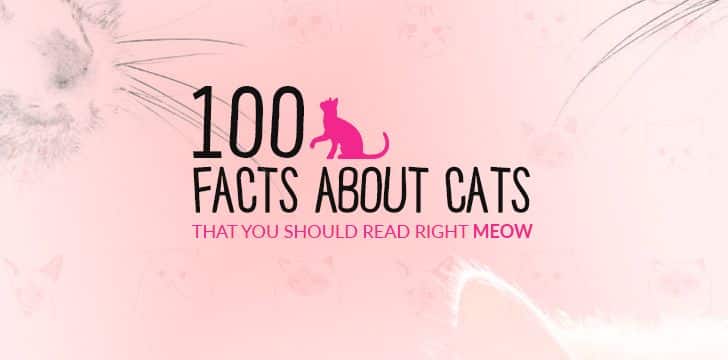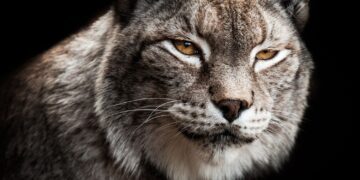If you love cats, you’re in for a treat today, as here we have 100 cat facts you won’t want to miss!
They’re cute, furry, and one of the most popular house pets in the Western world.
Have you ever wanted to overload yourself with an enormous amount of awesome facts about cats and kittens?
If the answer is yes, you’re in luck because, from this point onward, cat facts are all we’re going to be talking about!
So without further ado, here are 100 cute facts about cats and kittens!
The jury is out – Americans love cats more than dogs!
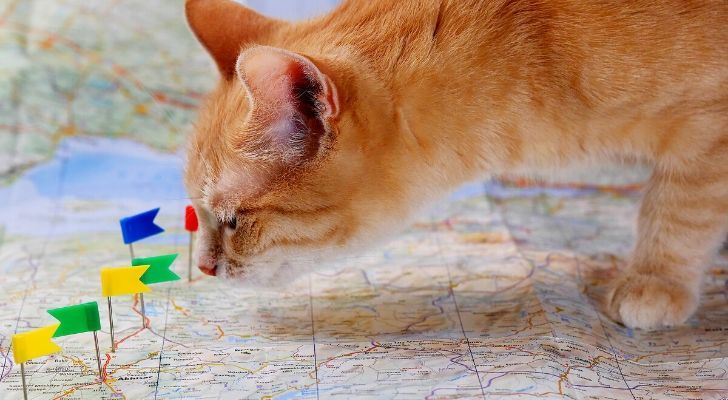
No American household is complete without a furry little friend.
While there are more US households with pet dogs, there are way more cats than dogs!
A 2019 survey of US households found there to be around 94.2 million pet cats, while there were only 89.7 million pet dogs.
That’s almost 5 million more cats than dogs!
A male cat is called a Tom. A female cat can be a Molly or a Queen.
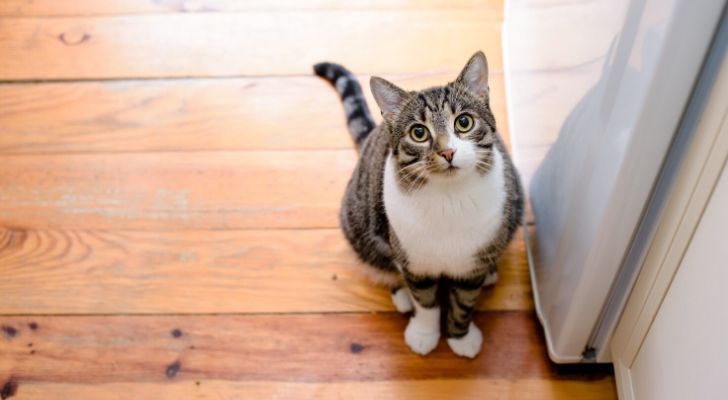
And no, we’re not just talking about the names that we give our feline companions.
We’re talking about the technical term to refer to cats by gender.
A male cat is specifically called a Tom, but a female cat is more complex.
Normally, a female cat would be referred to as a Molly, but if it’s pregnant with kittens, then it’s a Queen!
The saying, “A cat always lands on its feet,” isn’t just an old myth.
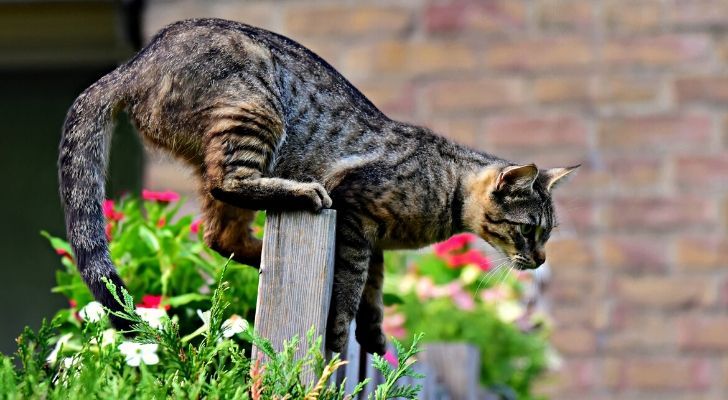
It’s actually accurate, in most cases, at least! Cats have a natural ability to land on their feet called the “righting reflex.”
This reflex allows cats to quickly assess which way is down and rotate their bodies while in mid-air.
The higher the fall, the more likely a cat is to survive it.
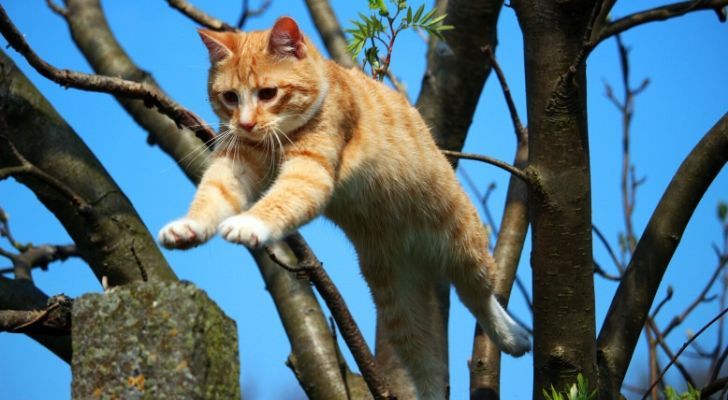
It turns out that if a cat falls from a lower height, say less than 7 stories high; then it’s actually more likely to be injured!
If a cat falls from a greater height, it has more time to correct its position mid-flight and prepare itself more for the landing.
There are even reports of cats falling from as high as 32 stories high and coming away with just a chipped tooth and a punctured lung.
There are many ways to refer to a group of cats.
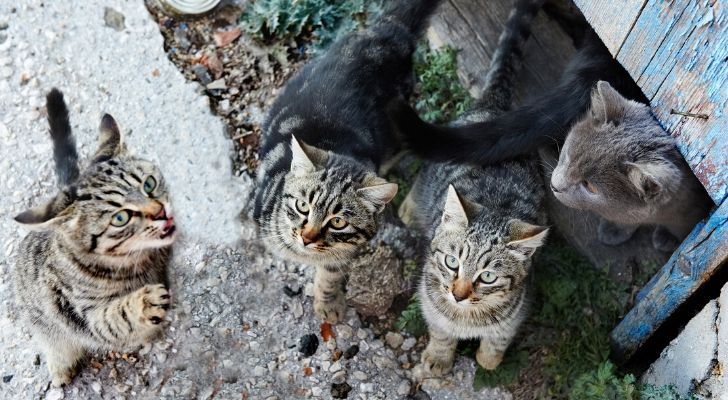
It really depends on the cats, too. The collective noun for wild cats, for example, is “a destruction of cats.”
Regular house cats are generally called a “clowder of cats.”
However, they can also be called a “glaring of cats” if the cats you’re referring to don’t know each other and are glaring at each other.
There are also quite a few ways to refer to a group of kittens.
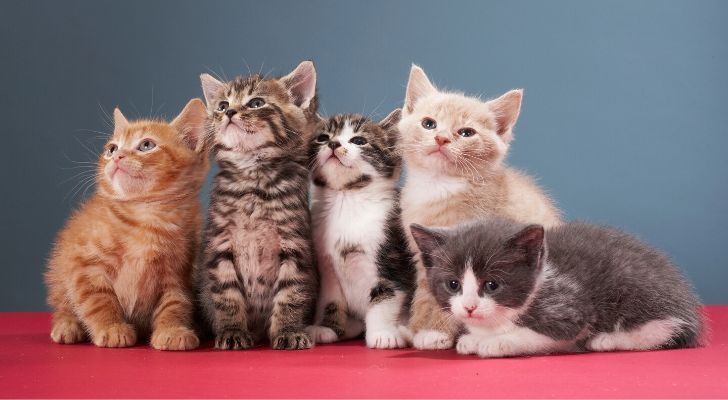
The most commonly used collective noun for kittens is “litter of kittens.”
They can also be called an “intrigue of kittens” due to their curious nature.
An “entanglement of kittens” is another name, as it’s often hard to tell where one kitten ends and another begins when they’re playing!
Finally, they can also be called a “kindle of kittens,” although this usage is less common.
It’s been scientifically proven that cat owners are healthier people.
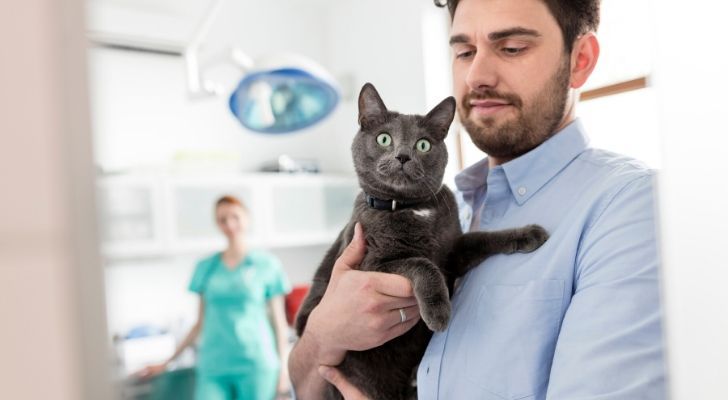
Patting a cat has been proven to release oxytocin, which lowers stress levels.
There’s also a clear link between cat ownership and a lowered risk of strokes or heart problems, as a cat’s purr lowers blood pressure.
Most importantly, cats keep you from being lonely – and it’s now known that loneliness plays a big part in many diseases!
Cats purr for many more reasons than you would think.
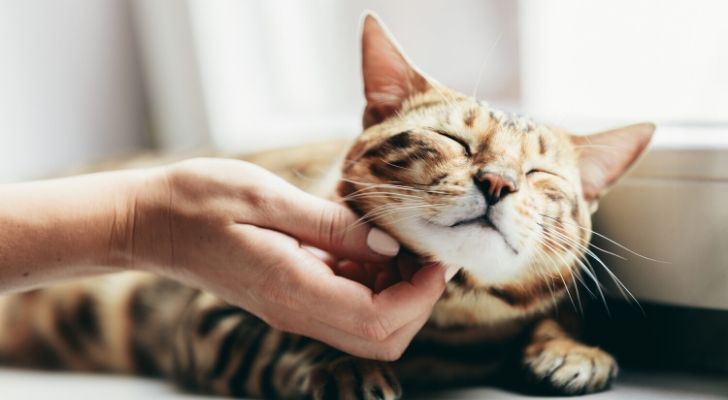
Most people associate a cat’s purr with it being happy, but that’s not always true.
Some cats have a slightly different purr for when they’re hungry, and mother cats also use their purr to communicate with their newly birthed kittens.
Most unexpectedly, cats sometimes purr when injured, and it’s been suggested their purr helps their body heal faster!
You should probably stop feeding your cat milk.
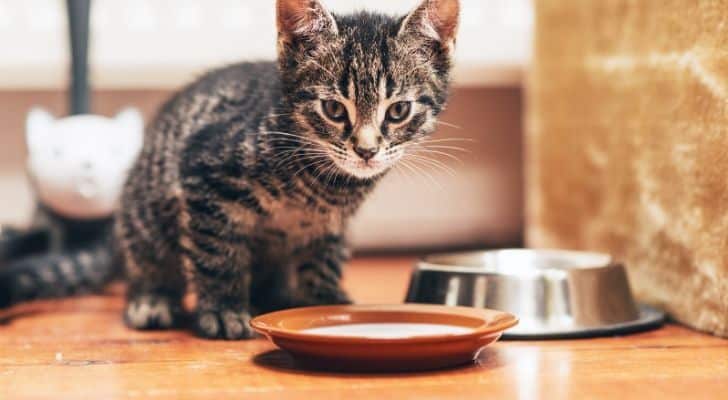
It’s common knowledge that cats are fans of milk, but many of them are actually lactose intolerant.
While kittens can drink their mother’s milk, feeding them cow’s milk could be very dangerous to their health.
If you really want to reward your cat with some milk, make sure you buy lactose-free!
Cat brains are very similar to human brains.
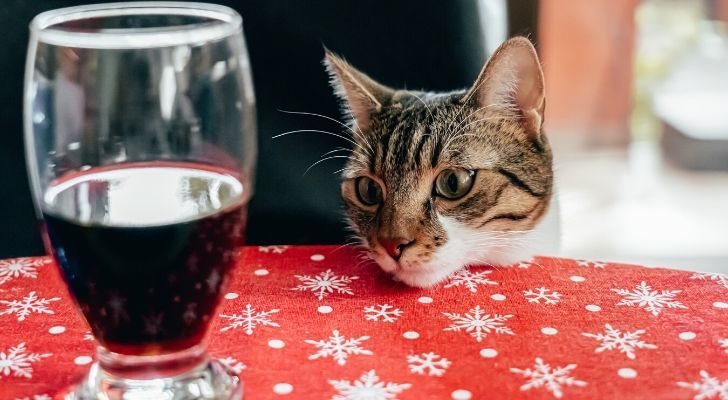
Physically, at least, their brains are about 90% similar to ours.
Their brains are smaller, weighing just 0.9% of their total weight, while ours weigh 2%.
While most people think that cats aren’t as smart as dogs, they can also be trained – they just think it’s a little bit beneath them!
President Abraham Lincoln was a bit of a crazy cat lady.

While he lived in the White House, he kept a number of pet cats, most famously Dixie and Tabby.
He adored all cats and would quite often bring home strays that he had found.
He was even known to feed Tabby directly from the table during formal dinners, much to his wife’s displeasure!
The first cat to take a trip to space was called Félicette.
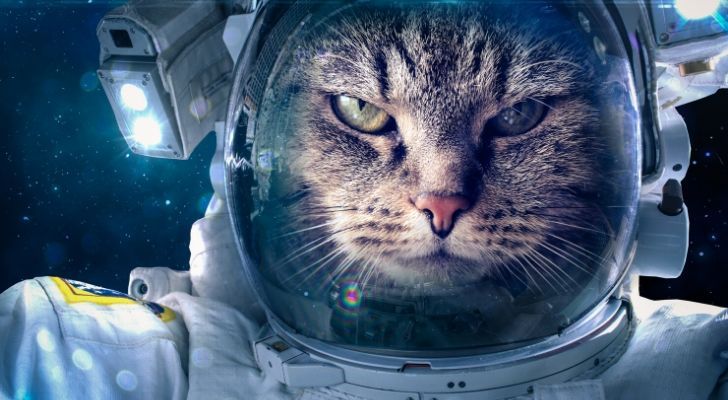
On October 18, 1963, a black & white “tuxedo” cat named C 341 was rocketed out into space, making world history.
Upon its safe return, it was decided that it deserved an actual name, so it was named Félicette, after the popular cartoon character Felix the Cat.
If you think of yourself as a “cat person,” you’re among 11.5% of people in the world.
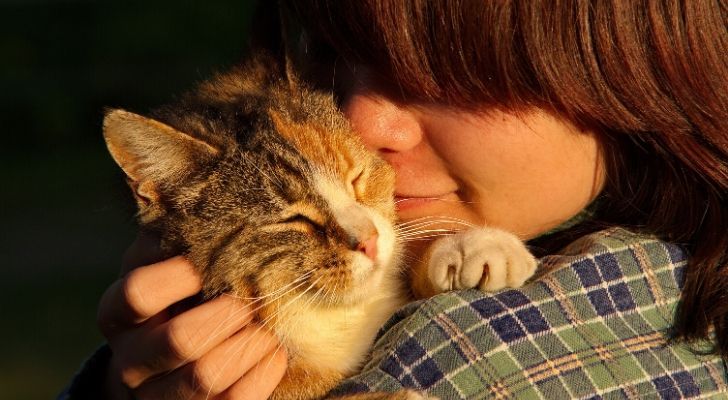
On the other hand, “dog people” make up 45% of the world.
“Cat people” are said to be more open but also more neurotic.
“Dog people” are quite different and are said to be more extroverted and hard-working.
The record for the largest number of kittens in the same litter was 19.
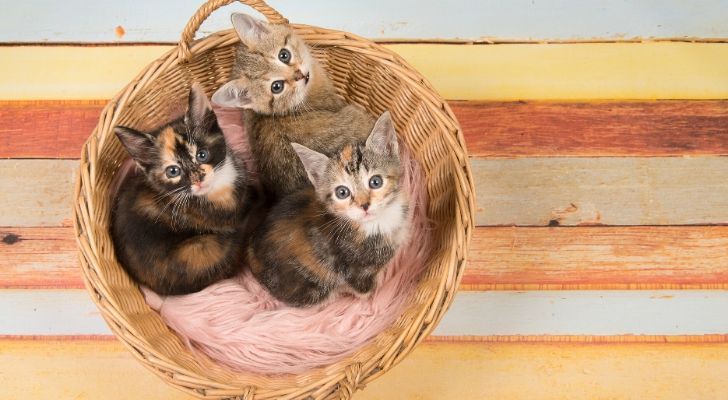
The record is held by a Burmese cat called Tarawood Antigone, who was just four years old at the time.
She gave birth to the entanglement of kittens on August 7, 1970, in her owner’s home in Oxfordshire, UK.
Of the fifteen kittens that survived birth, just one of them was female!
Over her lifetime, a cat called Dusty had a total of 420 kittens.
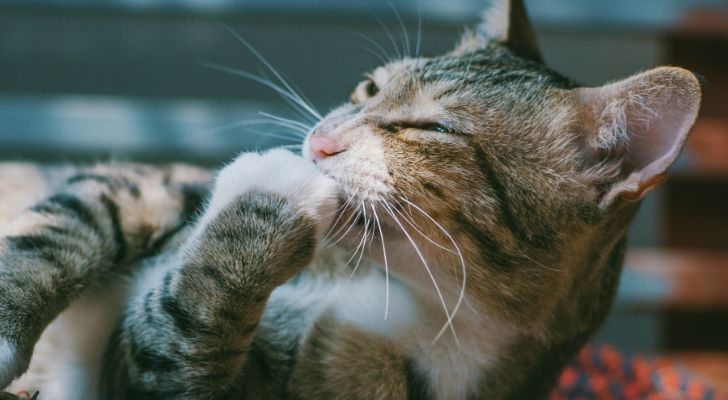
Dusty was your ordinary-looking cat with no pedigree or special background.
She lived with her owners in Bonham, Texas, where she gave birth to the world-record-holding number of kittens.
Her last litter was born on June 12, 1952.
The oldest known cat to give birth was 30 years old.
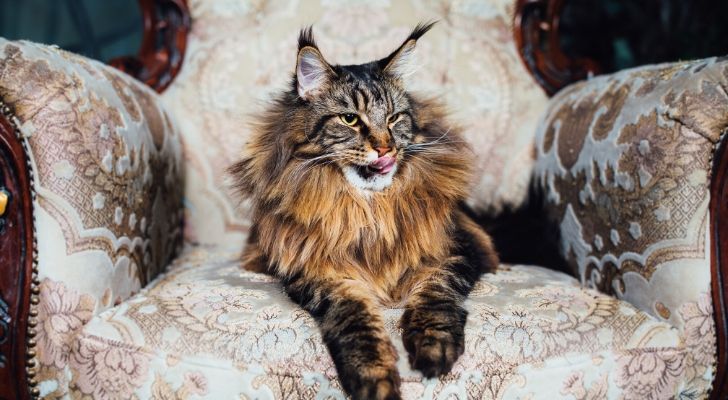
Her name was Kitty, and she belonged to a man called George Johnstone.
They lived in Staffordshire, UK, where Kitty broke the record by having a litter of two kittens when she was 30.
She gave birth to a total of 218 kittens throughout her life.
The British TV show “Bagpuss” was ranked as the fourth greatest kid’s TV show.
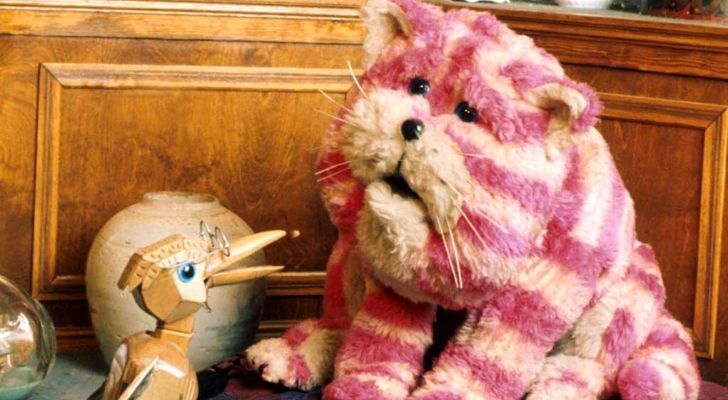
The TV show featured a cat sewn out of old cloth and falling apart at the seams.
Although it originally aired in 1974, the show was appreciated for a long time.
In 1999 the TV show was ranked as the 4th best TV show for children that ever aired on the BBC.
Unfortunately, cats are still consumed as food in some parts of the world.

The majority of the world loves cats and is appalled at the thought of eating one, but this is not the case everywhere.
Cat meat is still consumed today in some regions of Africa and Asia, whether legally or not.
In times of war, cat meat was also consumed in some European countries, such as Italy, France, and Spain.
There are around 60 different recognized breeds of cats worldwide.
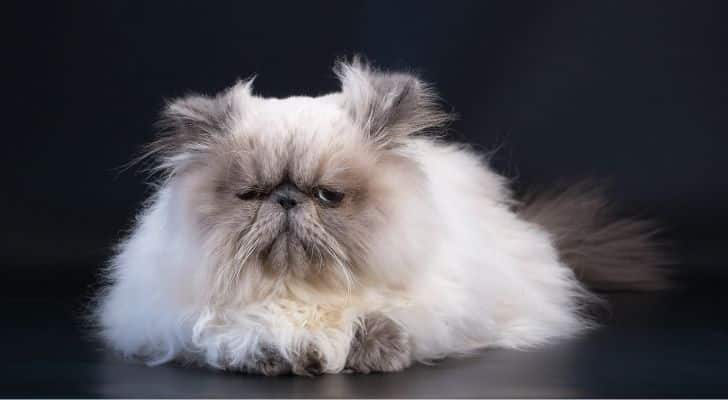
It really depends on who you’re asking, though.
The International Cat Association recognizes 71 different cat breeds, while the Cat Fancier’s Association only recognizes 44.
There is no official number because different people have different ideas about what makes a breed official.
There are more than 500 million pet cats in the world.

Although, once again, this is a very difficult number to be sure of.
There have been multiple attempts to count the number of pet cats worldwide, with some people even attempting this through an internet poll.
The general estimates say there could be anywhere between 200-600 million pet cats.
Ancient Egyptians worshiped a goddess who was half cat and half woman.

The goddess was originally known and worshiped throughout Ancient Egypt as Bast.
Bast was a vicious half-lion, half-human warrior goddess of the sun.
Over time she came to be known as Bastet, and instead of being half-lion, she was half-cat.
In Ancient Egypt, civilians would suffer severe punishment if they hurt a cat.

The cat goddess Bastet was one of the most popular deities within the Egyptian pantheon.
As such, cats were considered to be incredibly important creatures, bringing luck to anyone who looked after them.
From at least the year 450 BC, if anyone even hurt a cat, though, the punishment was death.
On average, cats sleep for about 15 hours per day.
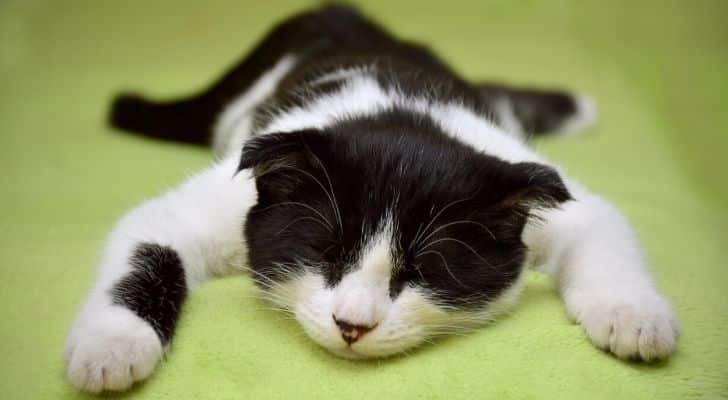
Cats are naturally nocturnal animals, which is why most domestic cats snooze throughout the day.
They tend to sleep for such a large portion of the day as they would normally require great amounts of energy to hunt for food.
Domestic cats still naturally try and conserve their energy for hunting, which can be used up by playing with toys instead!
Kittens require a lot more sleep than adult cats.
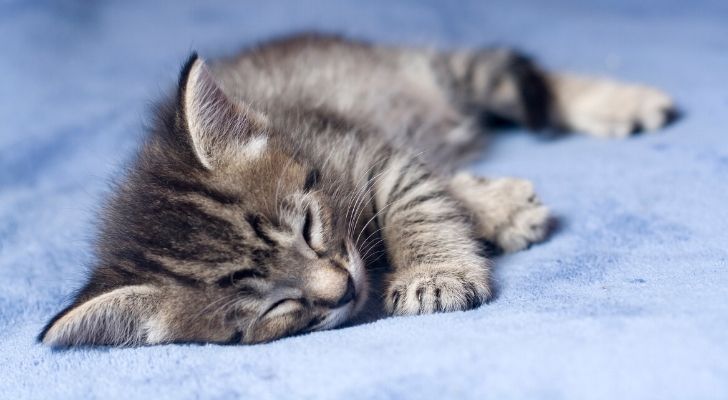
As a general rule, the younger a kitten is, the more sleep it will need!
Kittens require more time cat-napping than older cats as they are developing mentally and physically at rapid rates.
Newborn kittens, for example, sleep almost 90 percent of the time – or up to 22 hours a day!
Cats have more toes on the front paws than their back toes!
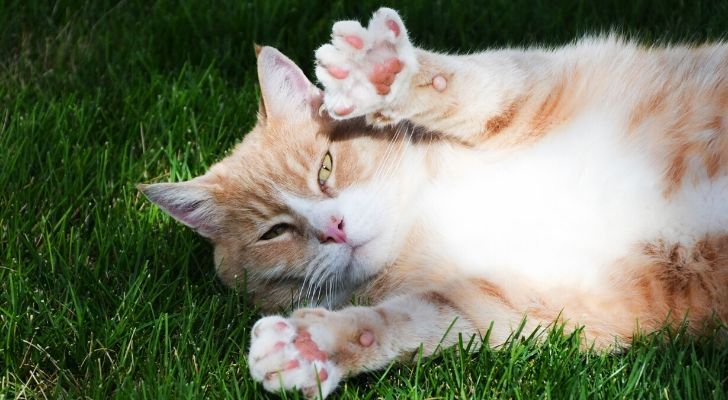
There’s a pretty simple explanation for it too, and it’s all to do with their front paws.
Cats use their front paws more for everyday activities such as catching prey, grooming and balancing themselves.
The amount of toes cats have is far from universal though, with some cats having more or less toes due to various genetic mix-ups.
Some cats can have up to eight toes per paw!
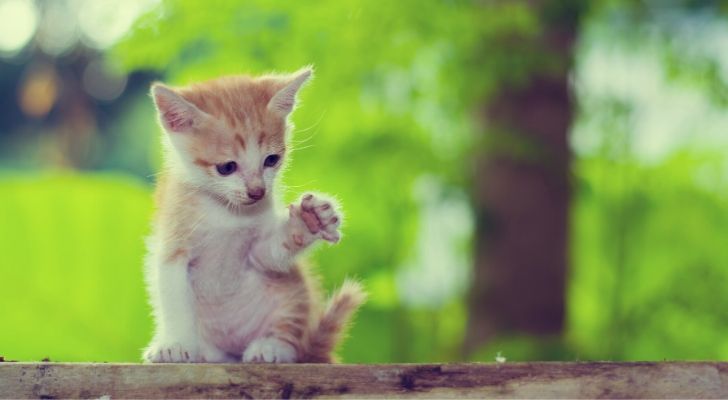
Cats with more than six toes on one or more of their toes are called polydactyl, which comes from the Greek term meaning “many fingers or toes.”
While it might be alarming to find that your cat has more than the regular number of toes, this is certainly not something to worry about!
It’s actually quite common for domestic cats to have a few extra toes, with some people finding their furry polydactyls even more adorable!
Cat’s taste buds cannot detect sweet things.
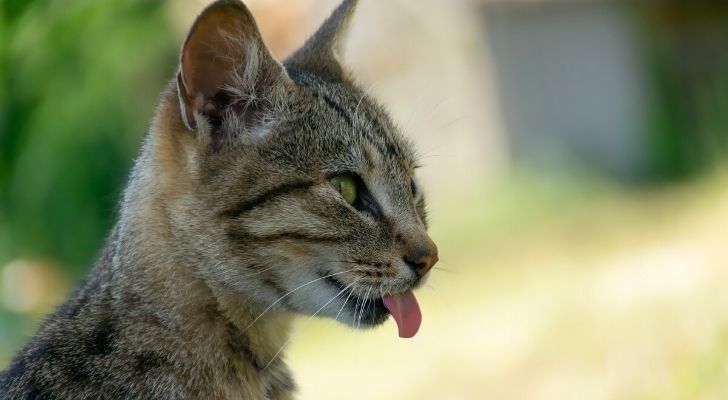
Many cat owners claim that their cats love things like ice cream, but it’s not the sugar they love – it’s the fat!
Cats, like most mammals, have different taste receptors.
Humans, for example, have at least five – sweet, umami, bitter, salty, and sour.
Cats, on the other hand, taste all but umami.
While they can technically taste sweet things, they detect them in such minimal amounts it’s like they can’t taste them at all!
According to urban legends, Isaac Newton invented the cat flap.
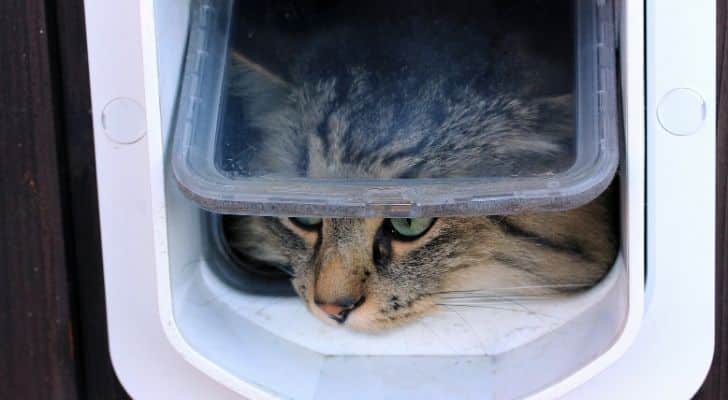
Humans have kept cats at least as semi-domestic pets since at least 7,500 BC, initially for their keen rodent hunting skills.
Holes have been cut in doors, walls, and barns for ages now with this very intent.
At some point along the way, someone invented the cat flap so that a cat could come and go as it pleased without creating a horrible draft.
An anonymous author published a story in 1893 relating to Isaac Newton creating holes in his door for cats, and ever since, he has been hailed as the inventor of cat flaps.
The issue with this story is that not only was it published 166 years after his death, but it also never even mentions a cat flap, just holes for his cats!
Neutering your cat can increase its average life expectancy by 62%!
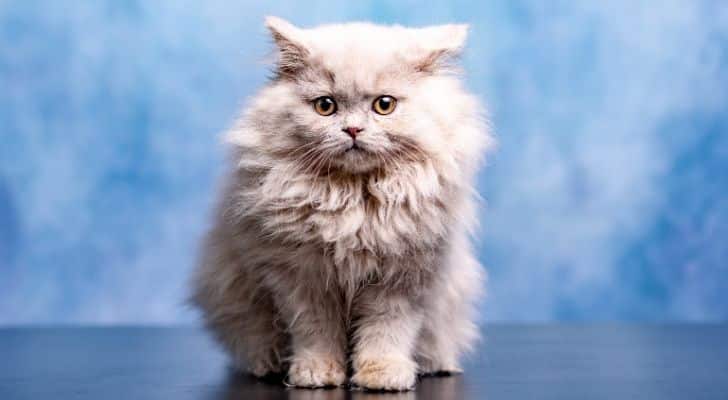
If you’re not planning on your cat being a parent to an almost endless stream of kittens, it’s probably a good idea to neuter it!
Now, though, there’s even more reason to:
A study by Banfield Pet Hospital, the world’s largest veterinary clinic, has announced that it can seriously increase your pets’ lifespan.
The data they analyzed showed that female cats could live, on average, 32% longer.
Males, on the other hand, could live, on average, 62% longer!
Cats have extraordinary night vision.
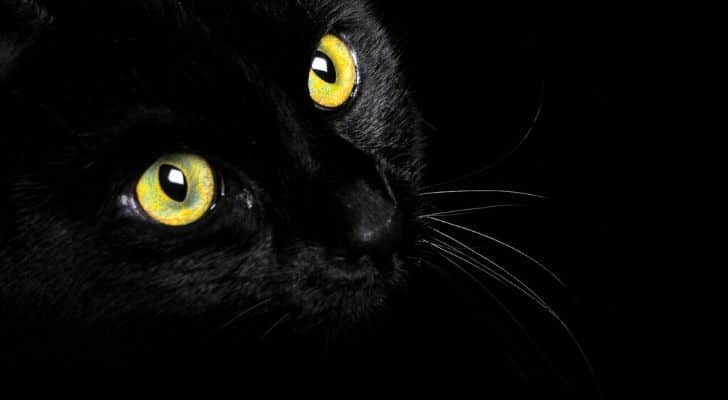
As mostly nocturnal creatures, cats rely on their eyesight to hunt at night.
While they can’t exactly see in complete darkness, they definitely have far greater vision than we do!
If there is no light at all they’re as bad as us, but otherwise, they only need about one-sixth of the amount of light we need to see.
Without a specific nutrient, cats can go blind.

If you take a quick peek at the back of a cat food bag, you’ll find that taurine is always a listed ingredient.
You may already be familiar with this amino acid, as it’s commonly an ingredient in energy drinks such as Red Bull.
If a cat goes without taurine for long periods of time, it can cause a variety of health issues, even leading to blindness!
House cats can run at a speed of 30 miles per hour.
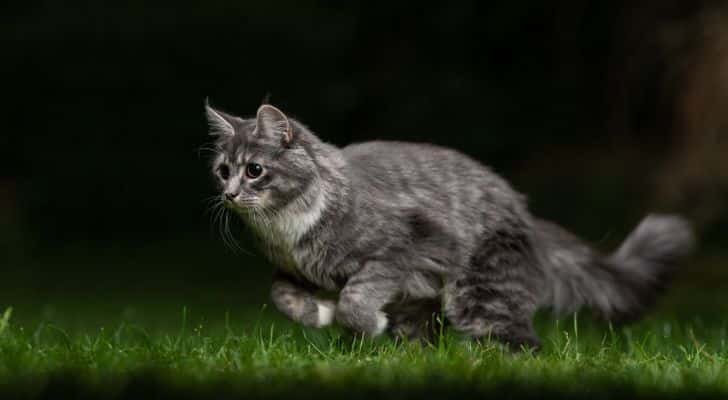
If you’ve been wondering why cats spend most of the day cat-napping, here’s a good explanation.
The average domestic cat can run up to 30 miles per hour (46km/h) and does so quite often!
To put this in perspective, that’s as fast as world-record-breaking sprinter Usain Bolt!
Those cute furry bits inside a cat’s ear are called “ear furnishings.”
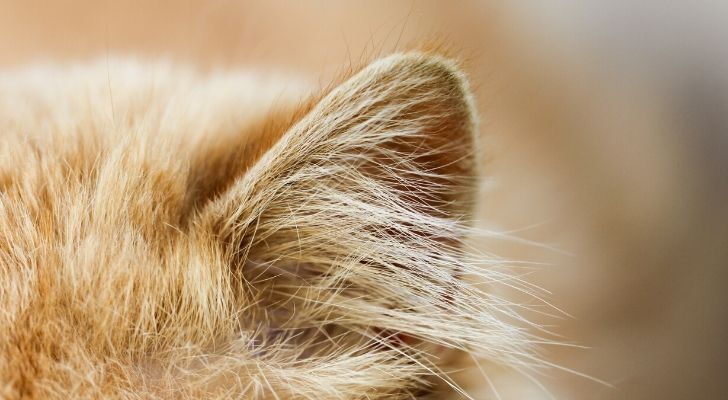
The hairs found inside a cat’s ears are much sought after in the world of cat breeding, but they also have a great use for cats too!
They ensure that dirt doesn’t go inside and also helps them to hear well by picking up sound vibrations.
It’s one of the reasons that cats are such great hunters!
Cats have a great sense of hearing and can hear ultrasonic noises.
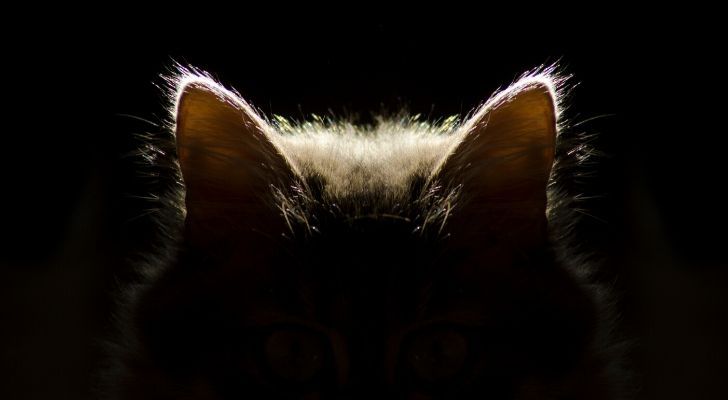
To put it mildly, cats have far superior senses than we do.
Not only are their night-vision leagues ahead of ours, but their hearing also outshines ours too!
Their ears can detect sounds ranging from the 55 Hz that we can pick up, all the way to 79 thousand hertz.
While this means that they can detect ultrasonic sounds, it doesn’t mean they communicate in such frequencies.
Instead, their ultrasonic sensitivities help them when hunting for animals such as rodents.
Most female cats prefer using their right paw, while males are more likely to be “left-pawed.”
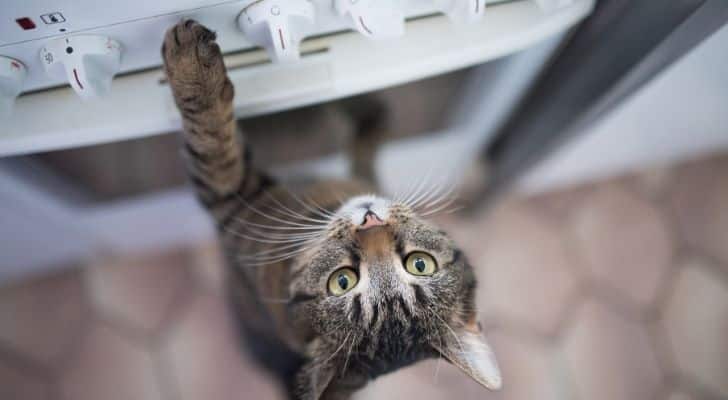
It’s not just humans who are right or left-handed.
While we humans are, for the most part, right-handed, this just isn’t the case with cats.
Studies have found that their preferred paw is more often associated with their gender.
The study tested a range of cats, monitoring which paw they would use first when ascending or descending stairs, reaching for treats, and stepping into their litter trays.
Cats actually have one more eyelid than humans do.
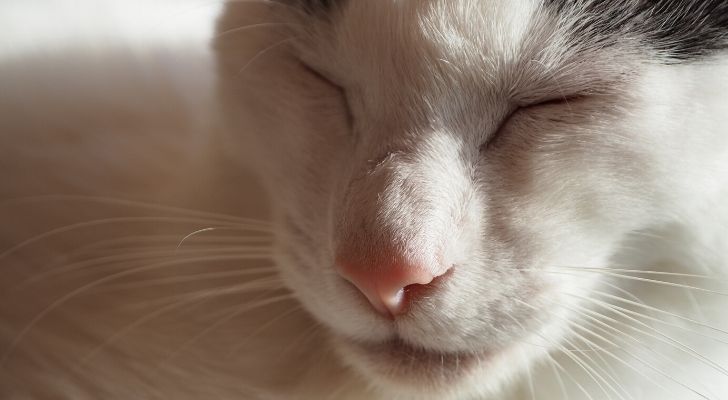
This third eyelid is known as the “haw,” and for the most part, it acts like a windshield wiper.
When a cat blinks, the haw swipes horizontally, removing any dust or debris.
You generally won’t ever get a chance to see a cat’s haw, but if you do, it could indicate an underlying health issue.
Nearly all animals have a haw, with humans and most other primates being the exception!
They might have an extra eyelid, but they don’t have any eyelashes.
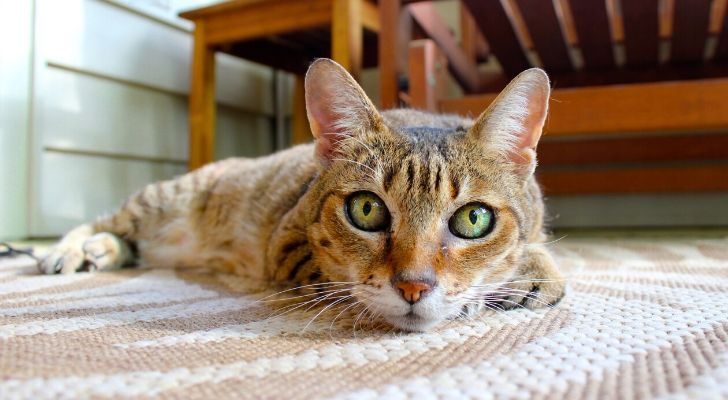
Other than making us look good, eyelashes have a pretty specific purpose. They help keep dust and other bits and pieces out of our eyes.
As cats have a third eyelid or haw, this just simply isn’t necessary.
Many cat owners claim their cat does indeed have eyelashes, but in reality, these are just longer bits of fur or even whiskers located above their eyes.
When a cat rubs up against you, it doesn’t necessarily mean they’re being affectionate.
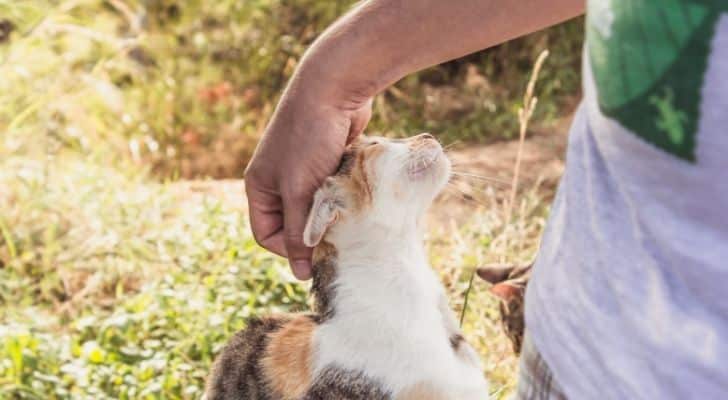
Generally speaking, when a cat purposefully rubs up against anything, it’s a way of transferring its scent to it.
Cats also have scent glands in their cheeks, so the same can be said about their habit of “head-butting” you.
So what does it really mean when they rub all over your legs? Well, it’s most likely that they are claiming that they are yours.
Now quickly, go give your new cat overlords a treat!
The cat family consists of many animals, but the tiger is the largest.
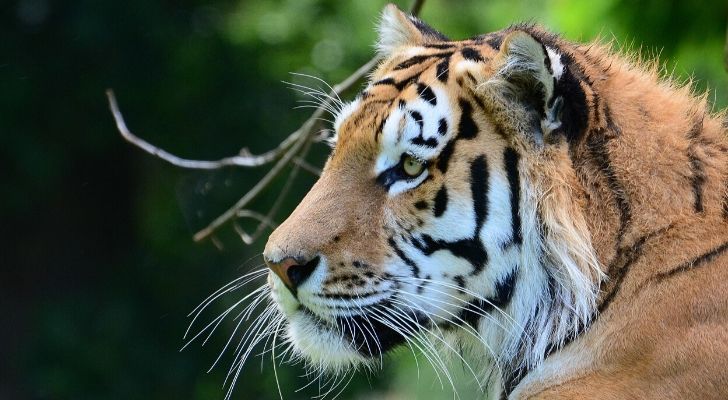
The family that includes domesticated cats, tigers, and all other felines is called the Felidae family.
The largest of all cats is the tiger, or Panthera Tigris, which measures up to 12.5 feet (3.9 meters) long.
Tigers aren’t just big; they’re phenomenally heavy, too, weighing anywhere from 143 to 717 pounds (65-325 kg).
There are two different cat species that contend for the title of “world’s smallest cat.”
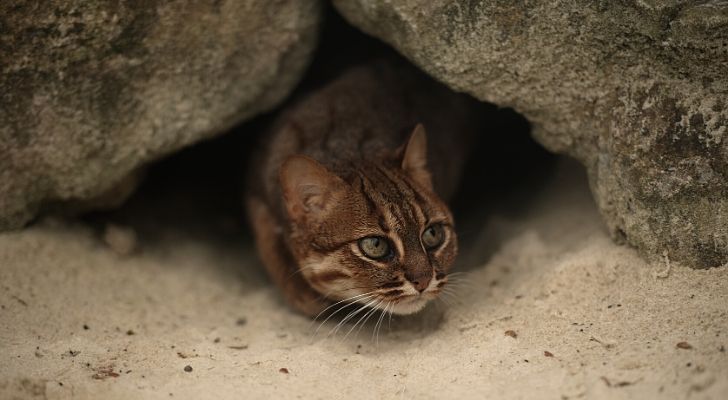
The black-footed cat (Felis nigripes) is native to arid regions of Southern Africa and has a maximum recorded weight of just 5.4 pounds (2.34 kg).
The other contender for the smallest cat in the world is the rusty-spotted cat (Prionailurus rubiginosus), which is native to India and Sri Lanka.
The former can be anywhere from 14 to 17 inches long (36.7–43.3 cm), while the latter has been recorded to measure from 14 to 19 inches (35–48 cm) from head to tail.
Taylor Swift’s cat is one of the richest cats in the world.
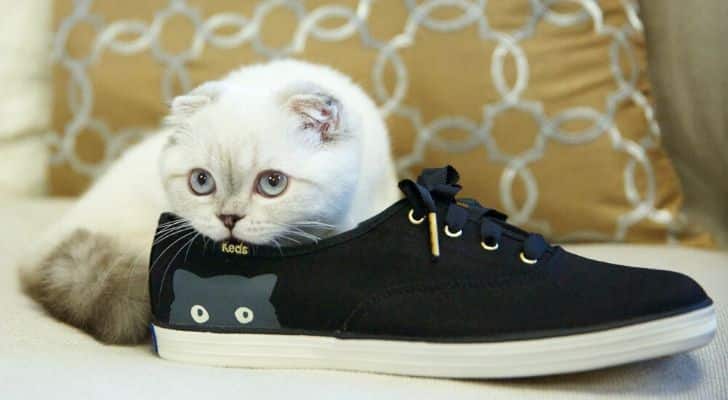
Of Taylor Swift’s three cats, Olivia Benson is by far the richest.
Unlike most other rich pets, Olivia Benson actually made most of her own money, sort of.
As of 2020, she was worth $97 million, which she gained through advertising certain brands such as Diet Coke and Keds.
The world’s first cat show took place in Hyde Park, London.
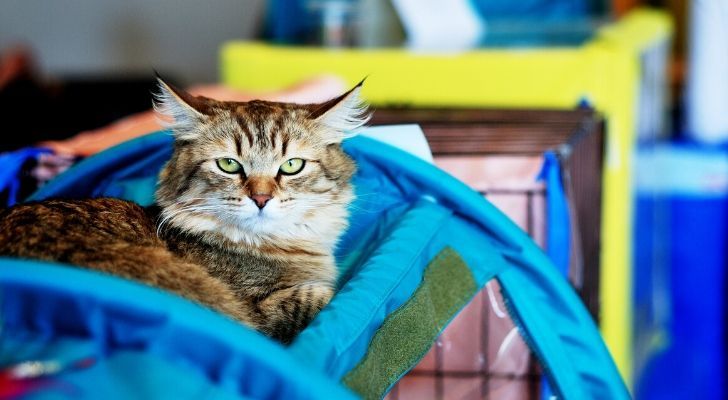
It was an event that started a trend that still takes place today.
Held in the famous Crystal Palace in Hyde Park, the cat show took place in 1871.
The flyer for the event claimed that there would be 500 rare and beautiful cats being showcased, including Siamese, Polydactyl, Manx, and Scottish Wild cats.
The show was an instant success, with more than 200,000 people attending the event!
It might not be the best idea to let your cat hunt mice.
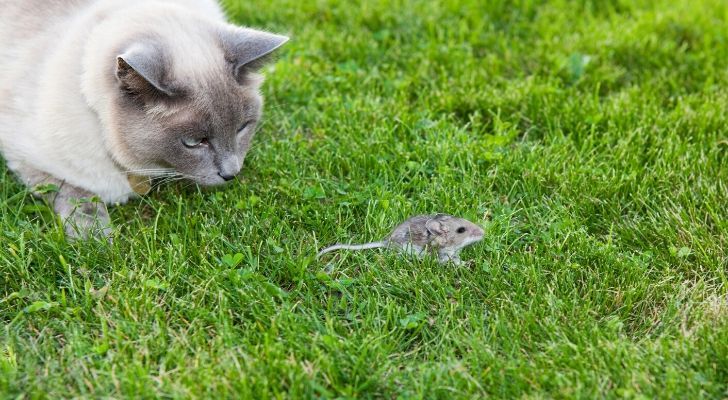
This might be a bit of an unpopular opinion, but if you value your cat’s health, then it’s time to stop using them to deal with your mouse problem.
Firstly, any mouse or rat that has eaten poison doesn’t die immediately, so if your cat ate such a mouse, it could be poisoned too!
Mice can also be infected with ticks, which your cat could then bring into the home.
This is particularly bad if those ticks are carrying Lyme disease!
Cats aren’t really that great at hunting rats, either!
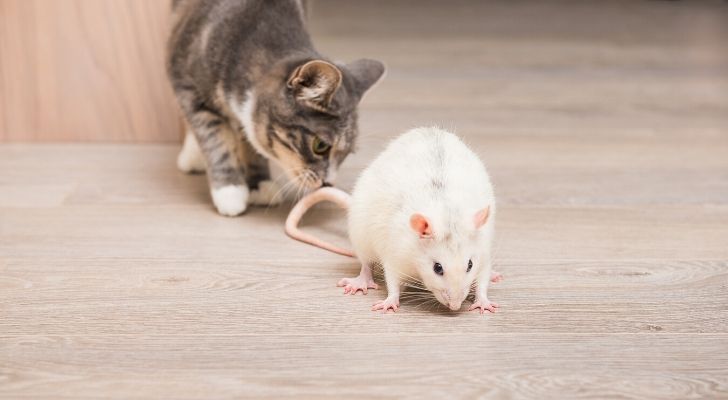
If you ask anyone how to deal with a rat problem, they’ll advise you to get a cat.
It’s an idea that has become more of a legend than a fact, though.
The reality is that cats will hunt whatever is easiest and available, which generally means they prefer to hunt birds, mice, and small lizards rather than rats!
Cat’s hearts beat around twice as fast as ours do.

A healthy cat’s heart rate is actually quite varied, depending on how relaxed or excited it is.
The normal range for a cat is anywhere between 140-220 beats per minute (BPM).
If a cat suffers from a heart condition or heart disease, the BPM can be more than 220.
Ancient Egyptian cat owners would shave off their own eyebrows when mourning for their dead kitties.

It goes without saying that ancient Egyptians simply adored their pets, especially the cats that graced their homes with their presence.
Whenever a pet cat passed away, there would be a mourning period in which the owners would shave their eyebrows off.
The mourning period lasted at least until their eyebrows grew back.
The oldest known breed of cat is most likely the Egyptian Mau.
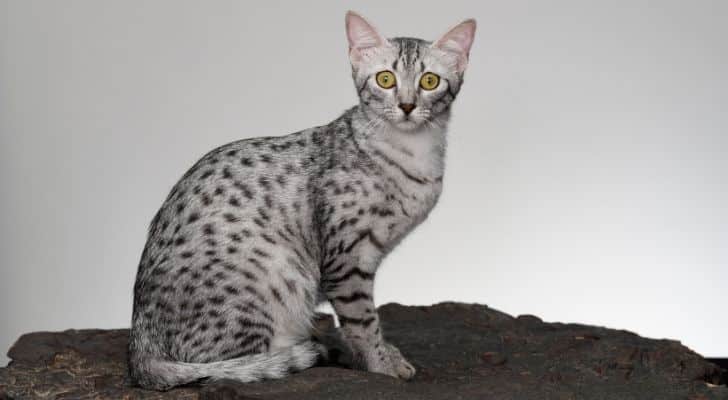
In fact, Mau is simply the Egyptian word for “cat.”
It’s quite difficult for us to know what the oldest domesticated cat breed was, but all evidence points to the Egyptian Mau.
While other cats didn’t come onto the scene until around 1000 AD, there are mummified remains of Egyptian Maus dating from at least 1500 BC!
Cats usually get along better with cats of the same gender.
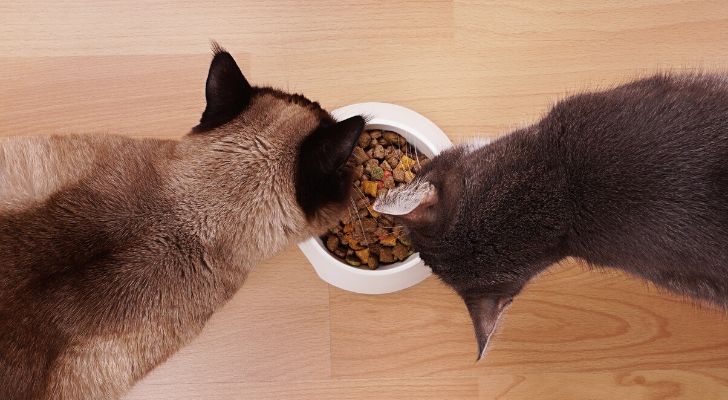
There are a lot of general rules when it comes to pairing cats.
Two male cats, for example, could have territorial issues and fight instead of bonding.
Bringing an older cat into your home isn’t the best idea either, as it will try to assert its dominance over your original cat.
Research has found that you should introduce a cat of the opposite gender instead– just make sure it’s neutered!
Feeding your cat smaller meals more frequently could be a key to a healthier lifestyle.
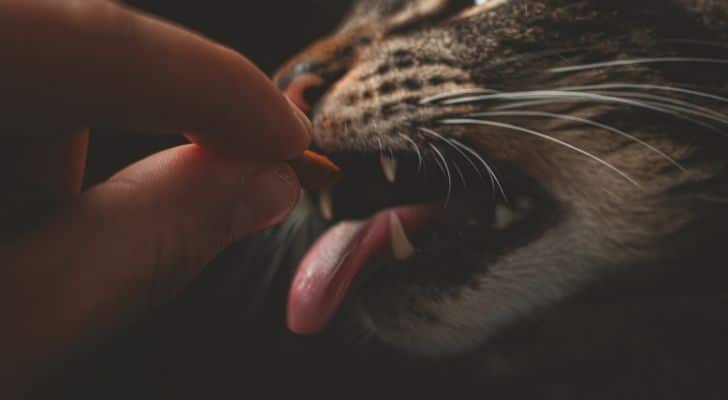
Research has shown that the closer a cat’s lifestyle is to that of a cat in the wild, the healthier and happier they are.
This same rule apparently applies to their feeding schedule, too.
Cats in the wild normally eat many tiny meals throughout the day as they hunt small animals.
You can simulate this by giving it five or more much smaller portions at different points in the day.
If you decorate your house with Poinsettia flowers at Christmas, keep them away from your cats!

Poinsettia is a popular flower to decorate with during Christmas, but if you have any furry friends in the house, you should stay vigilant.
The milky-white sap of the poinsettia plant is mildly toxic to both cats and dogs.
Although the flower isn’t deadly, it’s probably better to avoid bringing it into your house if you have pets.
Feral cats that live outdoors have a life span of around 2 years.
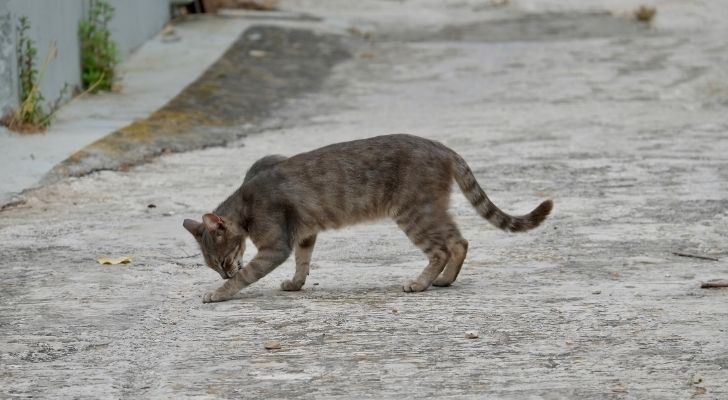
It’s quite a hard life for feral cats.
They’re constantly on the hunt for the next meal, a clean source of water, and appropriate shelter.
Combine this with the lack of medical care such as vaccinations, dental care, as well as any First Aid, and it’s no surprise that they live much shorter lives than their domestic cousins.
Indoor cats live much longer lives, with the average cat living for around 10 to 15 years.
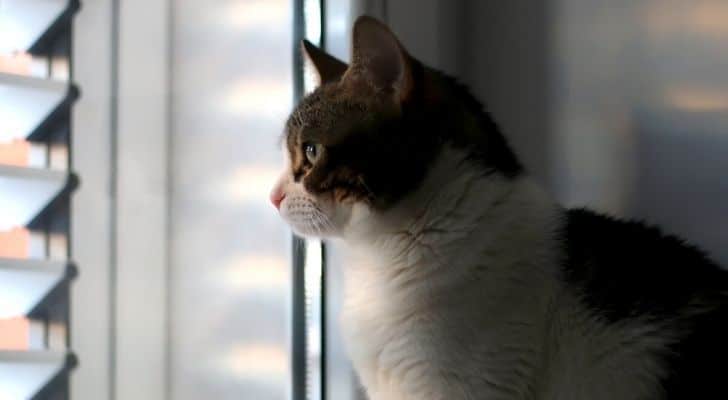
Domesticated cats generally live much longer, healthier, and happier lives than their feral cousins.
Some breeds of cats, such as the Manx or the Siamese cat, are known to live even longer lives, but this isn’t the only factor.
Providing optimal nutrition and sufficient exercise, as well as giving them appropriate medical care when needed, can greatly increase a cat’s life.
Feed a cat too much tuna, and they can become addicted to it.
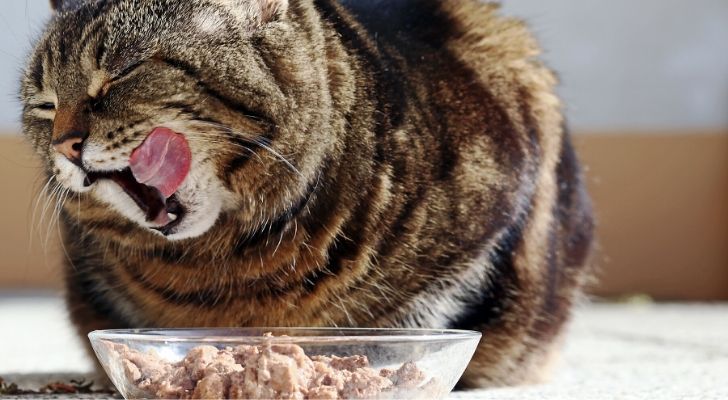
It’s a well-known fact that cats are massive lovers of fish.
If you feed your cat a small portion of tuna, you’ll probably notice they love it far more than their regular food.
It’s important to only give it in moderation, though, as they can actually become addicted to it and refuse to eat anything else.
This is an issue, as tuna does not provide all the necessary nutrients that a cat needs; in long term, a cat’s health will deteriorate on a diet of tuna.
There’s a good reason why a cat’s tongue is rough.
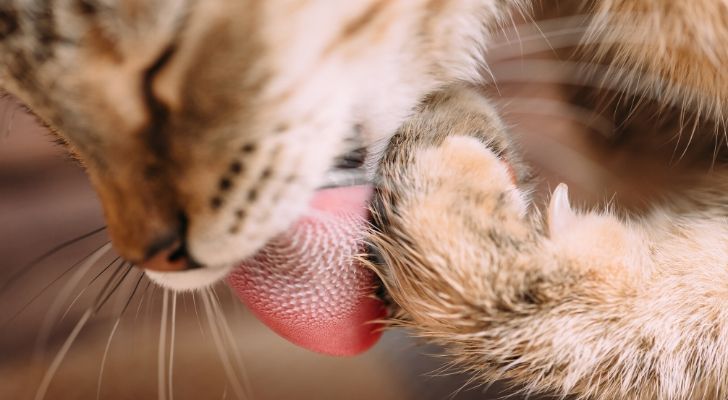
Being licked by a cat is a very strange sensation, and this is because of the tiny spikes (called papilla) that cover their tongues.
These spikes are no evolutionary accident, though.
The tiny spines help collect dirt, grime, and loose fur when they groom themselves.
They also act like a brush, which keeps fur from becoming matted or tangled.
All kittens are born with blue eyes.
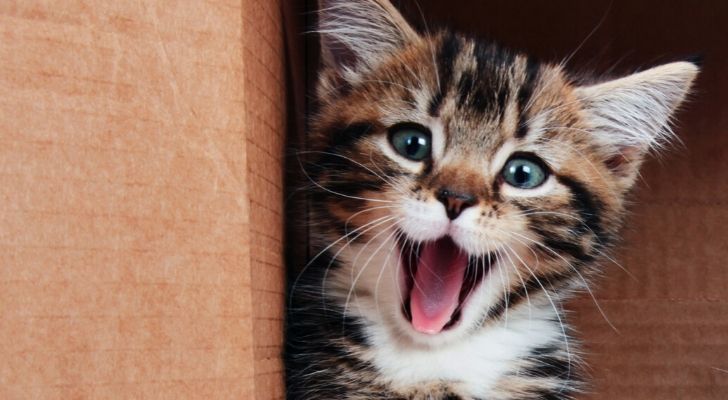
It turns out that this is true for all mammals, too, but the color isn’t exactly blue.
The reason their eyes appear to be blue is that the pigment which colors their eyes hasn’t developed yet.
It takes a few more weeks after their eyes open for the true color of their eyes to develop.
Nearly all white cats with blue eyes are deaf.
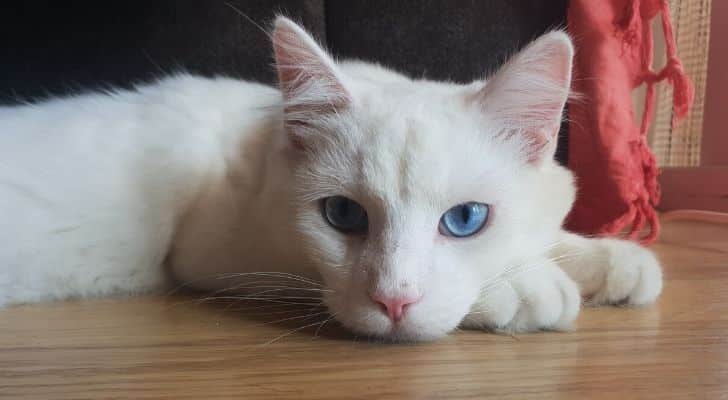
The gene that gives cats blue eyes seems to be closely linked to the gene associated with hearing.
Around 85% of all white cats with blue eyes will have some form of congenital deafness.
In extreme cases, these cats will be completely deaf, but if they’re lucky, it can just affect them in one ear.
Kittens begin to lose their razor-sharp teeth at around 3 months of age.
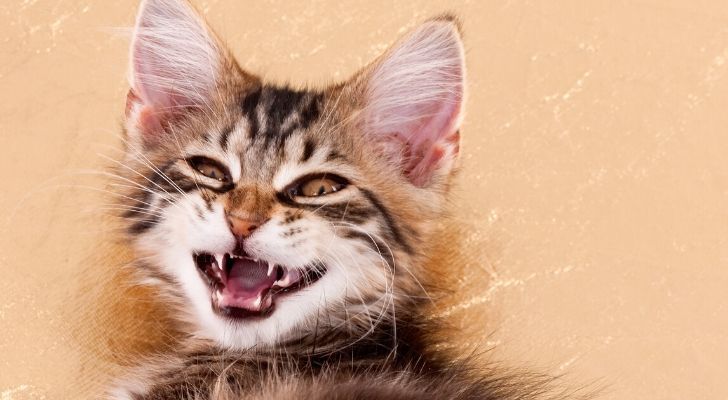
If you’ve ever played with a young kitten, you’ll know just how sharp their teeth are!
The good news is that they don’t have these teeth for long.
Cats have two sets of teeth, just like us. Their milk teeth grow first, with their adult teeth forming around the 1-month point.
By the time they are three months old, their milk teeth start to fall out, with their adult teeth surfacing beneath.
At around 6 months old, all 30 of a kitten’s adult teeth should have fully developed.
Most cats hate water, but one Turkish breed absolutely loves it!
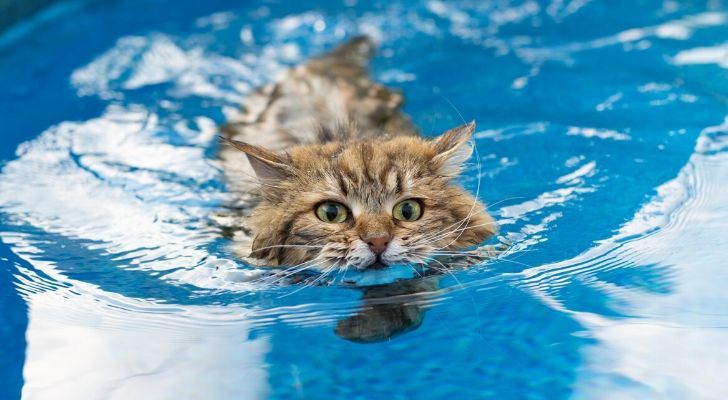
Nicknamed the “swimming cat,” the Turkish Van originates from the eastern Anatolian region of Turkey, by Lake Van.
They’re one of the known breeds of cats that consistently has a love of water.
They have a silky medium-length coat of hair and are quite often found splashing in any water they can find – rivers, streams, or even puddles!
A small amount of fat is actually good for your cat’s health.

In fact, fat is absolutely essential in a cat’s diet.
Many essential vitamins and nutrients can only be absorbed properly with the aid of fat, so a lack of fat can be bad for a cat’s health.
Certain fats are also a good source of Omega 3 and 6, which are good for their joints, kidneys, intestines, and skin!
Just remember to keep everything in moderation; otherwise, you’ll end up with a fat cat!
Just as a human’s fingerprints are unique, each cat has a completely different nose.
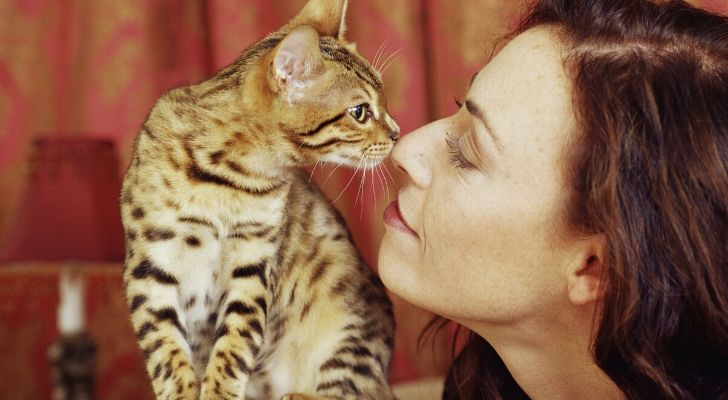
The next time you get up close and personal with a cat, take a closer look at its nose.
You’ll find that they are covered in hundreds of tiny bumps.
The pattern these bumps and ridges make is unique to every cat.
Maybe one day, we’ll be able to scan cat noses to identify them instead of using microchips!
Many people are allergic to cats, but cats can also be allergic to humans.
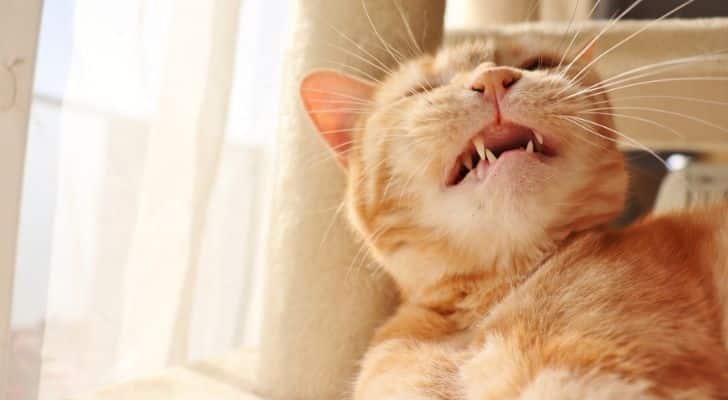
Both humans and cats can get seasonal allergies from pollen, dust, and other particles like grass seeds, but this is no surprise.
The surprise here is that cats can be allergic to us like we are to them!
In such rare cases, cats can be allergic to the dead skin and other particles that we shed throughout the day.
Around 60 percent of cats in the US are obese.
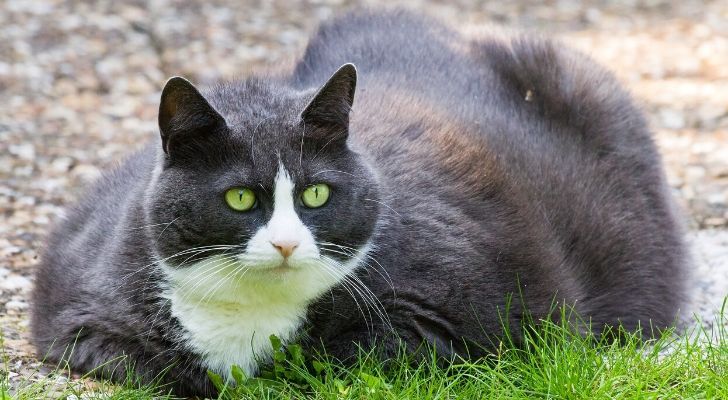
It’s a figure which is, unfortunately, rather similar to American adults.
While fat cats may be quite adorable to look at and provide us all with some much-needed joy, their weight could seriously impact their health.
It’s always important to keep an eye on your cat’s weight and make regular trips to the vet to keep their health in check!
We’re not the only ones who can develop dementia – it turns out cats can too.
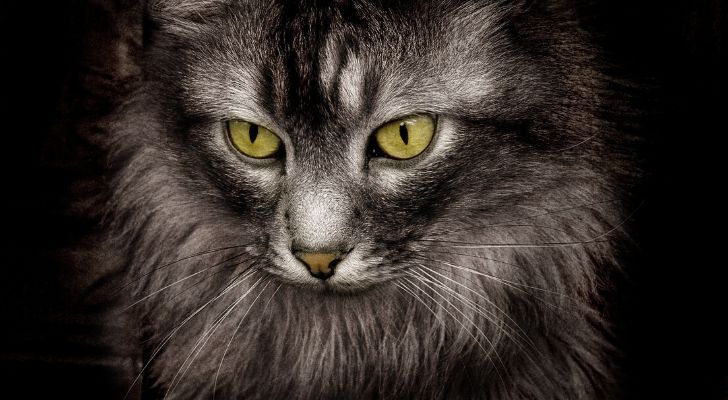
Cats and humans have another thing in common – the older we get, the more our mental and physical health goes downhill.
Just like us, cats can develop a condition similar to dementia called cognitive dysfunction syndrome (CDS).
CDS can affect a cat’s responsiveness, general awareness, and memory, as well as being a major cause of anxiety.
Unfortunately, there is no cure for CDS. The best thing you can do for a cat with CDS is to ensure it is fed a balanced diet and gets plenty of physical and mental stimulation.
Cats have been domestic animals for at least 10,000 years.
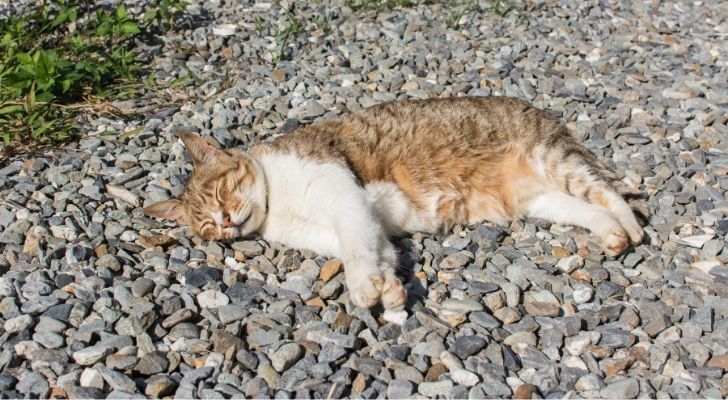
The oldest record of a tamed cat comes from the island of Cyprus. Remains of an African wildcat were found in the same burial ground as a human.
No cats are native to the island, so the villager must have brought the cat to the island and tamed it there.
Interestingly, the notion of cat breeds didn’t come to life until much later, in the 19th Century.
Pet cats can actually become ill due to changes in routine and environment.
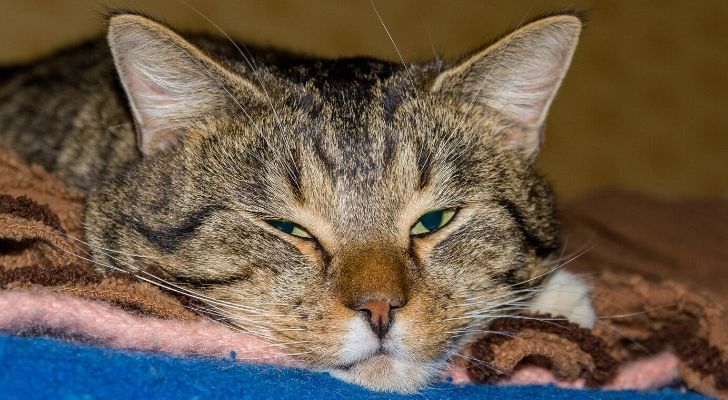
Refusing to eat, vomiting, or going to the bathroom outside of their litter box are commonly passed off as “cats just being cats.”
It turns out that there’s actually a very solid reason for cats to act like this, and it’s far from voluntary!
Cats can become ill and act like this if you change their routine or environment too much.
If you find your cat acting up in such a way, try and reduce the variation in your life, and it could solve the issue!
Cats developed a special type of purr to get their way with humans.
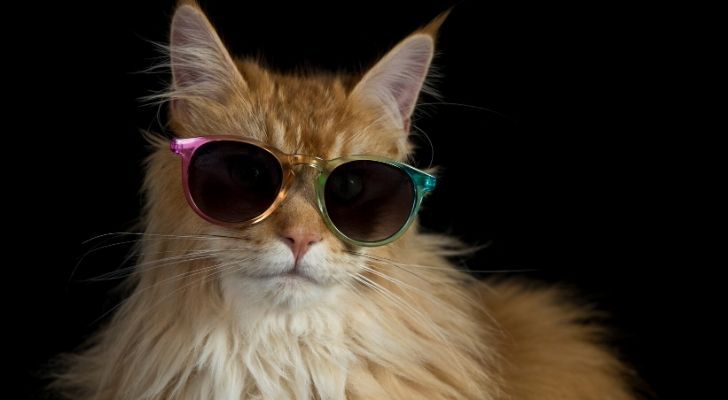
If a cat meows at you for food in the middle of the night, you’re probably going to get annoyed and try to shoo it away.
But here’s the cutest cat fact you could possibly read:
As a reaction to this, cats have developed a hybrid sound that combines a purr and a meow, and they actually modeled it off the sounds babies make!
This hybrid sound is much more likely to get you up and out of bed to feed them in the dead of night, so it definitely works!
There’s a good reason cats always nap in warm places.
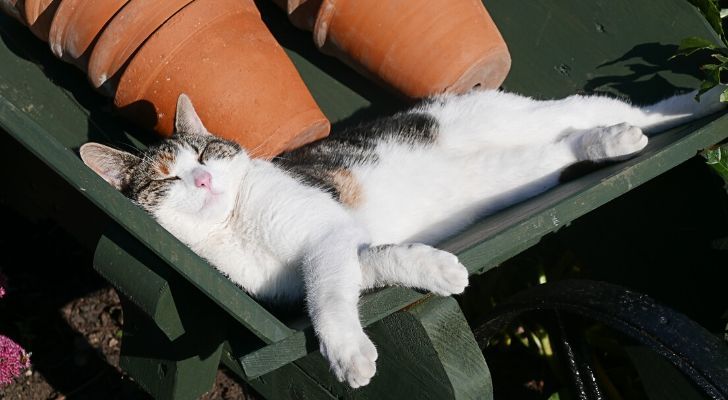
Have you ever noticed that if a cat has a choice in where to cat-nap, it’s generally in a warm place like on top of a radiator, in a sunbeam, or even on your laptop?
It turns out that cats have a good reason to seek out warm spots to nap.
Any external warmth helps cats to regulate their body temperature without the need to expend any energy.
This means that they can save their energy for more important things, like meowing in the middle of the night and passive-aggressively knocking things off your desk.
If your cat isn’t drinking water, it could be because of the water bowl’s location.

A cat drinking water from literally anywhere except its water bowl is a common complaint among cat owners.
The explanation is a rather simple one, with roots returning to the wild ancestors of domesticated cats.
Cats instinctively avoid water sources that are potentially contaminated, meaning they won’t drink water when it’s too close to their food.
The solution? Keep the food and water bowls separate, and make sure you top them up with fresh water regularly!
There are, unfortunately, many more reasons a cat won’t drink water.
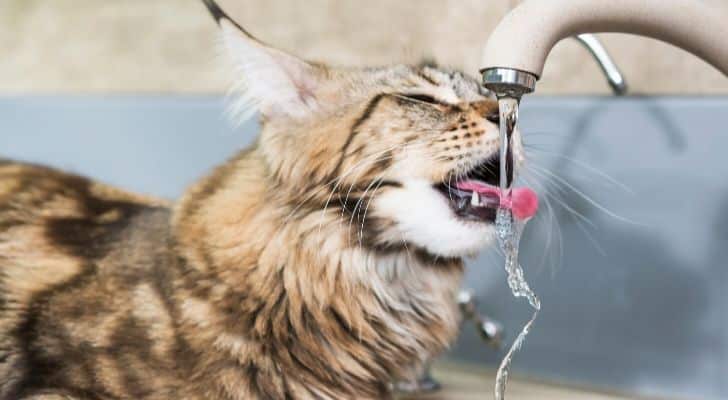
If you thought the answer to your cat’s drinking problem would be simple, think again!
Some cats prefer to drink running water, while others simply disapprove of the bowl you have chosen for them.
Even pickier cats will refuse to drink from a bowl if the level of the water is too low or too high!
Cats are responsible for the extinction of at least 63 animals and counting!
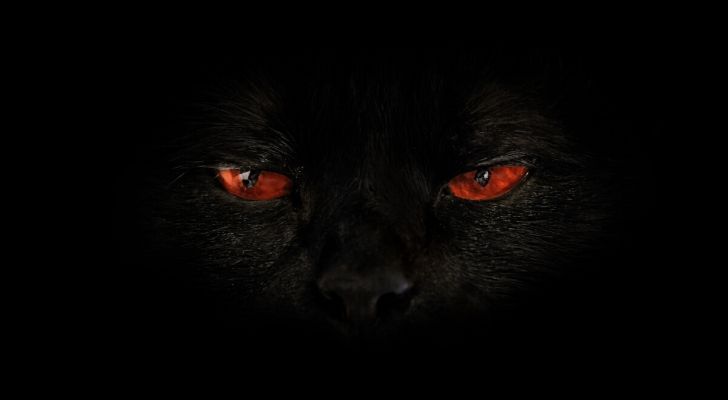
The next time you’re wondering whether your kitty should be an indoor or outdoor cat, consider this.
As of 2016, at least 63 mammals, birds, and reptiles have disappeared off the face of the earth for good due to cats around the world.
The reality here is that cats are generally an invasive species and are not part of the normal food chain.
Their predatory abilities are simply too good, and this is putting a lot of wildlife at risk!
There’s a parasite you can catch from cats that are connected with uncontrolled anger issues.

The parasite is called Toxoplasma gondii, and in general, it’s something best to avoid.
It’s been linked to a number of mental health issues and can strongly affect pregnant women and those with weak immune systems.
It was also found that people infected with the parasite were less able to control their anger, with fits of rage twice more likely than normal.
The good news is that cases of infection are becoming more and more infrequent as general hygiene levels are increasing!
Although you may never notice it, cats also sweat!
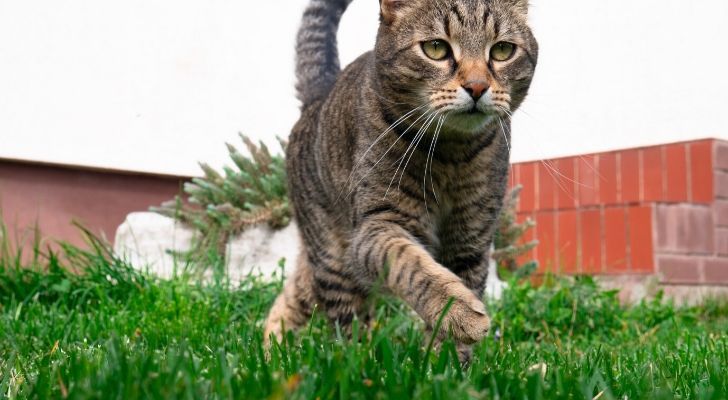
We’re not the only ones to cool ourselves down by sweating. But have you ever noticed your cat sweating?
There’s a reason you haven’t! They only sweat through areas that are not covered in fur.
The largest sweat glands are on their feet, and this is why you might see damp paw prints on a hot summer day.
Disneyland Park “employs” nearly 200 cats.

Shortly after Disneyland Park opened its doors in the 1950’s it began to have issues with rodents.
Fortunately for the park and its visitors, the problem soon began to solve itself; a group of feral cats had moved into the park and begun to hunt the unwanted mice.
The park staff soon realized the value of the cats and has since taken care of them and their offspring.
Cats use their whiskers to judge whether they will fit through an opening or not.
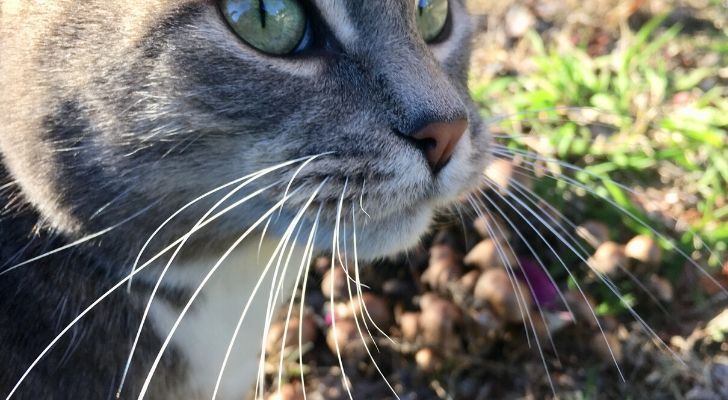
The whiskers of a cat are long, flexible hairs that are attached around its mouth, eyes, and even on the backs of its legs.
Other than looking quite dashing, their whiskers are about as wide as their body is.
This aids cats greatly, as they can determine whether they can fit through a gap or a hole just by sticking their head through it and testing whether their whiskers fit.
You can also tell the mood of a cat by its whiskers.
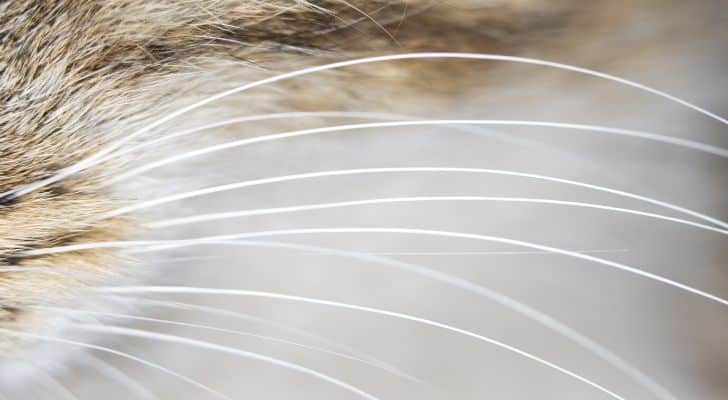
If a cat is in a good mood, feeling generally content, or even curious, it will relax its facial muscles, and its whiskers will be pushed forwards a little.
You can also determine whether a cat is angry or defensive by its whiskers, as they will pull its whiskers back.
Kittens from the same litter can have different fathers.
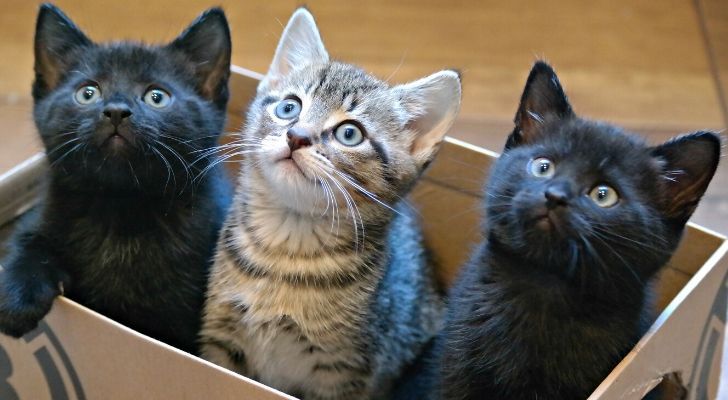
If a female cat breeds with a single male cat, then all of the kittens will be their sole offspring.
However, if the female cat breeds with any other male cats during the next 20-50 hours, though, things can get a little complicated!
For example, if a female cat breeds with five male cats during this period and then has 5 kittens, it’s possible for each kitten to have a different dad!
The term for this is called Superfecundation and isn’t unique to cats. The same thing can happen with dogs, too!
Cats can rotate their ears 180 degrees.
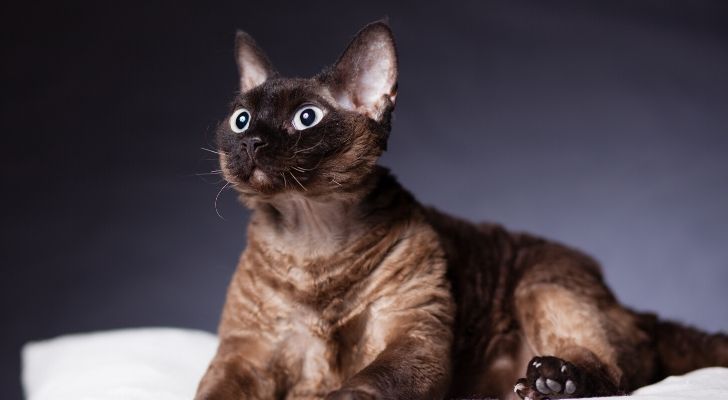
If you call a cat’s name, there’s a strong chance it won’t even get up to come to you.
Instead, it will turn its ear towards you to listen to you.
In fact, cats can rotate both of their ears 180 degrees in different directions at the same time.
This means that they can listen carefully to anything, anywhere, with their combined 360-degree hearing abilities!
Yet another way to tell a cat’s mood is by watching its ears.
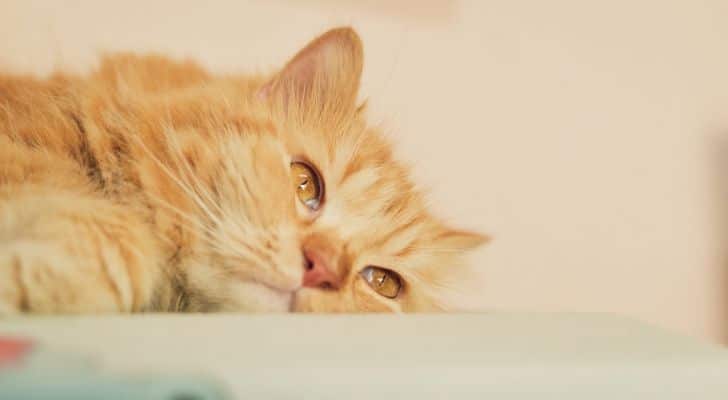
Cats are relatively complex creatures, and we often understand so little of what is going through their heads!
Another way we can get a bit of insight into what they’re feeling is by paying attention to the position of their ears.
If their ears are angled slightly, pointed forwards but still relaxed, then they’re probably happy!
Although if a cat is angry, it will normally flatten its ears against its head to protect them in the case of a fight.
If a cat is a little bit nervous or upset by something, its ears will generally shake slightly.
Keep the chocolate to yourself; it’s poisonous for cats!

Most people know that dogs are fiends for chocolate, but it’s quite toxic for them.
Less known, though, is that it’s just as bad for cats – fortunately, they just don’t seem quite as fond of it.
Cocoa products such as chocolate contain an ingredient called theobromine.
Humans are able to digest this completely, but our furry friends simply cannot.
Instead, it builds up in their bodies and can lead to serious problems such as liver failure.
If you do discover your cat has got into your chocolate stash, the best thing you can do is to take it straight to the vet.
Cats are pretty amazing at jumping; they can jump up to six times their own height!
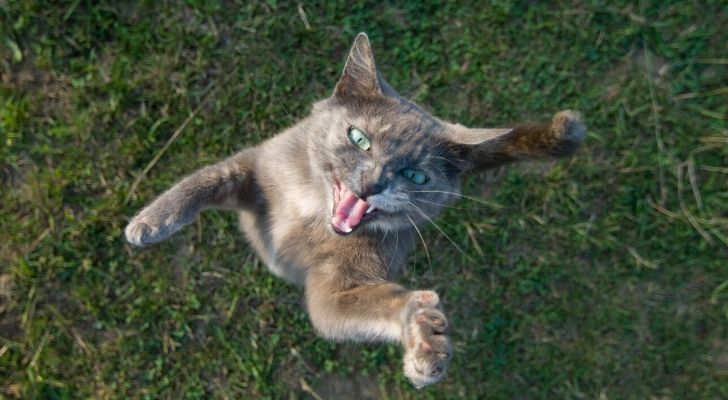
The heights that cats reach when they jump never cease to amaze.
It turns out the reason for this is rather simple, too, and it comes down to their powerful leg muscles and long limbs!
An average-sized cat of good health can jump as high as 8 feet (2.4 m).
The more practice jumping a cat gets, the better it generally becomes at it.
This is why outdoor cats usually excel at it, while your average indoor cat ends up becoming a star on the internet due to yet-another spectacular failure!
There’s a charming reason your cat brings dead mice to you. It means that your pet likes you!
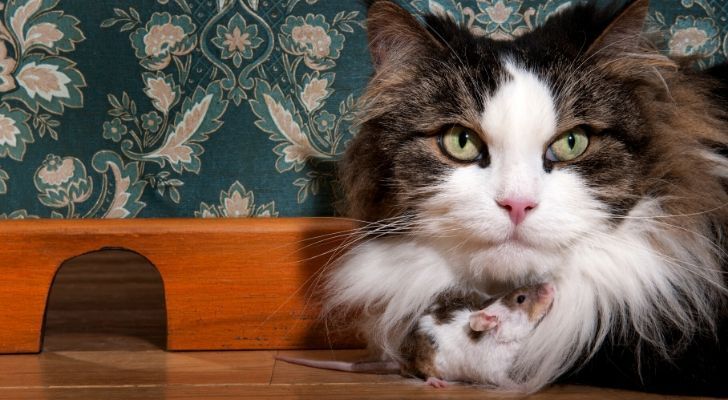
In fact, it means that they consider you to be a part of their pack!
It’s most common for female cats to bring little “gifts” to you as they feel the instinctive need to share their hunting skills with you.
So the next time your cat wakes you up in the middle of the night by dropping a dead mouse on your pillow, just remember that it means your cat thinks you suck at hunting!
No hard feelings, right?
You should never, ever, ever feed cats a vegan or vegetarian diet.
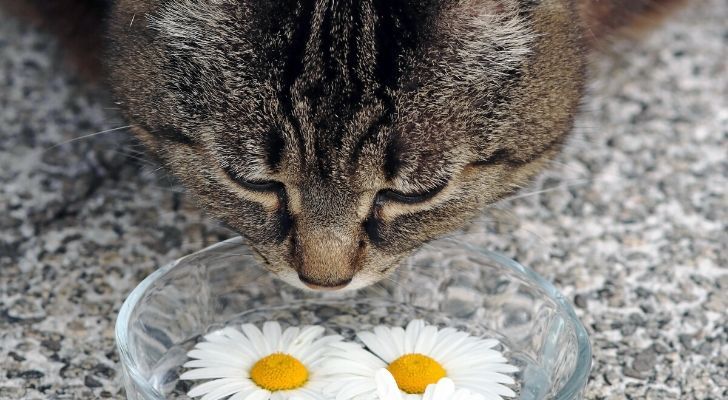
It doesn’t matter what your own dietary beliefs are, cats simply need meat to thrive.
While we are omnivores and can survive and do well on a meat-free diet, cats are carnivores.
The reality is that any cats that are fed anything other than a meat-based diet will develop serious health issues that can turn fatal.
While it is possible to find vegan and vegetarian cat food supplies, you won’t ever find a respected vet who would ever dream of recommending them.
If you want to get a cat but don’t want to feed it meat, you should probably consider getting a guinea pig instead!
Cats can find their way home even if they have traveled miles away; we have no idea how they do it!

Maybe you’ve experienced it personally, or maybe you’ve heard a story from a friend of a friend.
The classic tale of a lost cat making it home despite all odds is both heartwarming and confusing.
While we’re still not exactly sure how they manage to do it, we have some theories.
Some claim that cats can detect the earth’s natural magnetic fields and can navigate using them.
A more realistic theory is that they use their amazingly powerful senses to retrace their steps, often covering miles of territory to return home.
In most cases, outdoor cats don’t roam too far from home.

While there are always exceptions, the majority of cats roam no further than four or five houses away from their homes.
Males tend to explore further afield than females, with their territories extending to a 1500-foot (457 m) radius from home.
Females explore much less, with the average female cat only exploring a radius of around 750 feet (228 m) from home.
When it comes to adoption, black cats are the least popular.
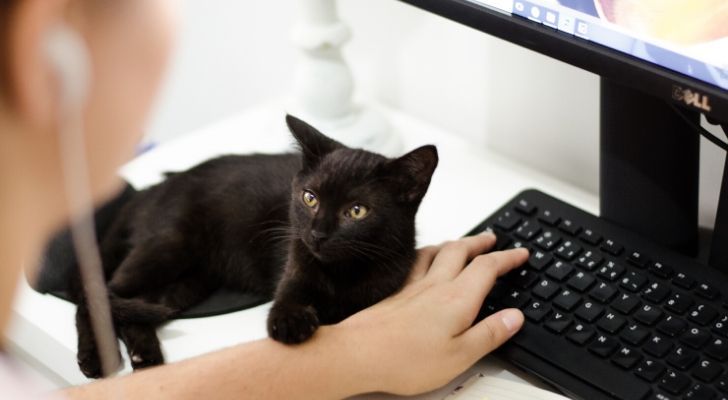
Unfortunately for black cats, superstition is alive and well, apparently.
For hundreds of years, black cats have been associated with witchcraft & bad luck.
Whatever the reason, this is bad news for black cats, with their tabby counterparts being twice as likely to be adopted.
A cat’s tail will quiver if it is near somebody it loves.
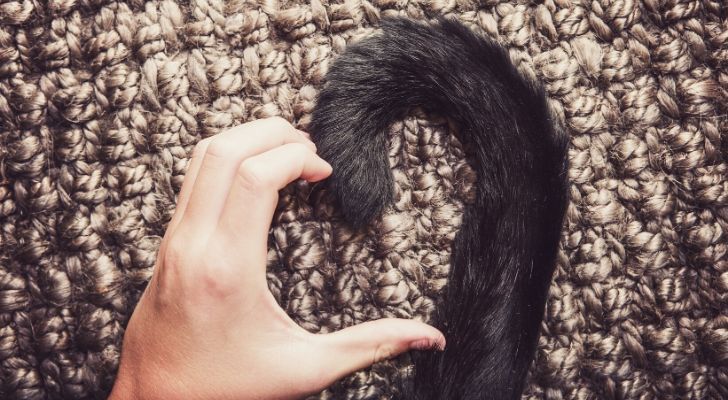
While we cannot speak to cats to understand what they are thinking, there are some clues they give us.
Cat’s tails are the most expressive parts of their bodies. They use them to communicate their different feelings.
If a cat’s tail is pointed straight up and shaking or quivering, it means they’re happy, excited, and glad to see you!
There are many more meanings we can gather from a cat’s tail, too!
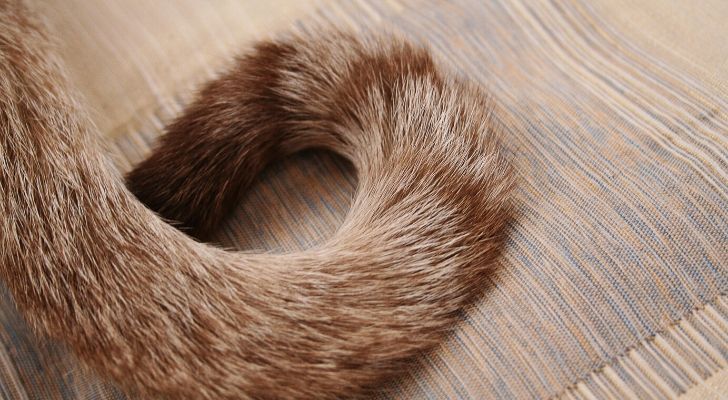
If a cat is shaking its tail and swinging it around almost violently, it’s probably best to leave it alone as it’s very, very annoyed, or even angry!
A slight flick of their tail every now and then can also be a sign of annoyance.
If just the tip of their tail is twitching a little, it can mean that they’re deeply concentrated on something.
The most alarming message a cat’s tail can give is when they’re angry, scared, or getting ready to fight.
In this case, the hairs of its tail stand on end, puffing the volume of the cat up!
Cats enjoy spending time alone.
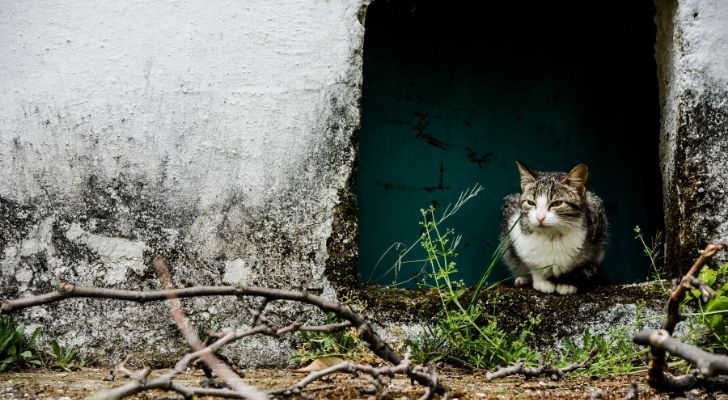
Unlike dogs, they don’t need much attention and can be very happy without any companionship.
While most people imagine their cats pining for attention while their owners are out and about all day, it turns it this isn’t quite true.
Cats actually enjoy solitude most of the time, with your daily absences giving them the rest they’ve been waiting for!
You shouldn’t feed many cats from the same food bowl.
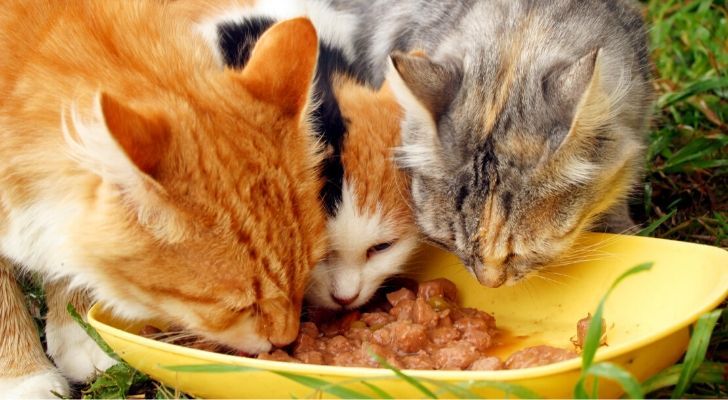
It’s best practice to start feeding your cats from different bowls.
While they may all be willing to share a bowl in the beginning, it’ll get more complex over time.
As cats age, they develop different dietary needs, so training them to use individual bowls from the beginning is much easier.
While not as much as dogs, cats can get aggressive during feeding times. Separate bowls can help prevent this.
Parsley, sage, and other herbs are among a cat’s favorite foods.
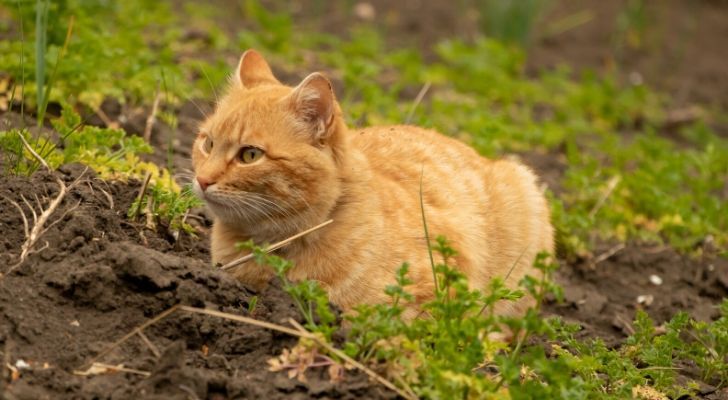
It’s tempting to fill your house with a wide variety of plants to give the place a bit of color and freshness. Although be careful while doing so if you have any feline friends hanging about.
There are many common plants and flowers which vary from mildly irritable to highly toxic, which should never be brought into the home.
Some of the more commonly found dangerous plants include any types of lilies, aloe vera, daffodils, geraniums, and tulips.
You should make sure that you do thorough research before bringing any new plants into the house.
If you put a collar on your cat, make sure it’s not too tight.
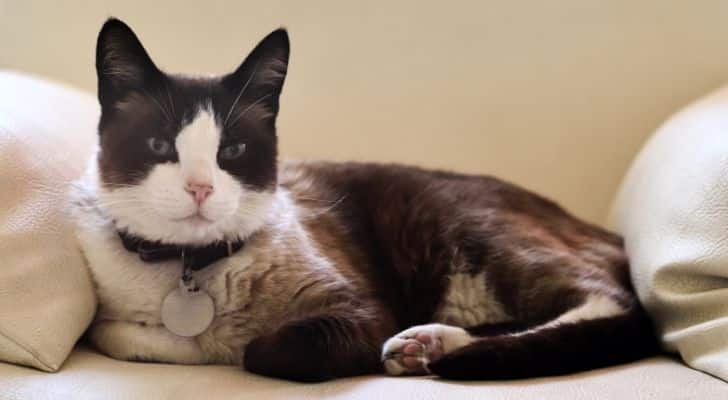
There are many good reasons to put a collar on a pet cat; they’re not just cosmetic.
Even though you may have microchipped your cat, a tag on a collar is the first place anyone will look for identification or contact details in case it becomes lost.
A bell on a collar can also prevent your cat from hunting the local wildlife.
The best collars are those that have a buckle that will snap open if it gets caught on anything to prevent injuries to your cat.
It’s also important to not have the collar too loose or tight, with it ideally being loose enough that you can fit 1-2 fingers underneath it.
The oldest cat to be recorded lived to be 38 years old.

Creme puff was an average-looking tabby female cat who lived a more than-average life.
Born on August 3, 1967, she spent her years with her owner Jake Perry in Austin, Texas, until her death on August 6, 2005, at the ripe old age of 38 years and 3 days old.
Perry often claimed that Creme Puff’s unusual diet was a key to her old age, with the diet consisting of dry cat food, eggs, broccoli, coffee with cream, turkey bacon, and even small amounts of red wine!
If you have an unreasonable fear of cats, you may have Ailurophobia.
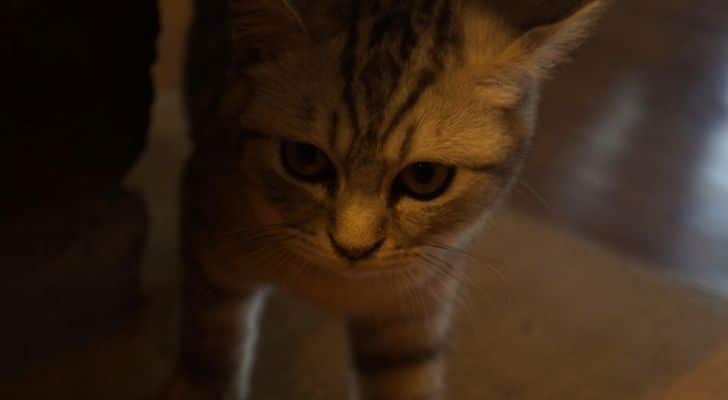
It’s the term for an intense fear of cats; for some people, it’s a very, very real condition.
It is also known as elurophobia, gatophobia, and felinophobia.
We’re not just talking about a mild dislike of cats, either.
If you have a phobia, then you’re at the point where you’ll think of any way you can to avoid them.
Even cartoon versions or photos of cats can freak you out. Even these cat facts would be scary!
A cat was the honorary mayor of an Alaskan town for 20 years.
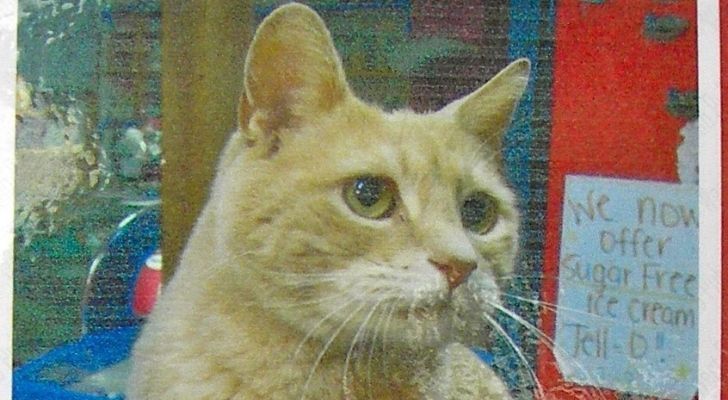
His name was Stubbs, and he ruled the town of Talkeetna from 1997 until his death in 2017.
He became the town’s unofficial mayor when disgruntled residents mailed in their votes for him due to a lack of better human alternatives.
Stubbs’s adoptive parents ran Nagley’s General store in the town, which subsequently became his unofficial mayoral office, drawing 30-40 tourists a day.
The record for the world’s longest cat is 48.5 inches.
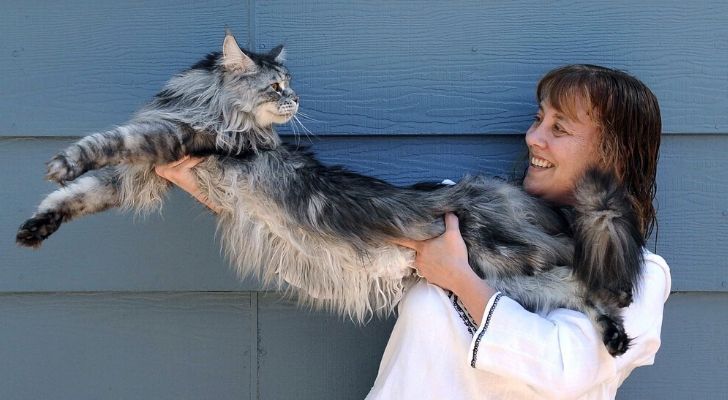
Such a long cat deserves a long name, and this cat’s name doesn’t disappoint!
His full name was Mymains Stewart Gilligan, although his friends called him Stewie.
In 2010 his owners in Nevada, USA, decided to enter Stewie for the record of the longest cat in the Guinness World Records after many of their friends remarked upon his enormous length.
He measured 48.5 inches (123 cm) long and gained the record for the longest cat that same year.
As of 2020, Stewie still holds the record for the longest cat to ever be recorded officially.
Cats do recognize their owners’ voices but often act like they don’t care.
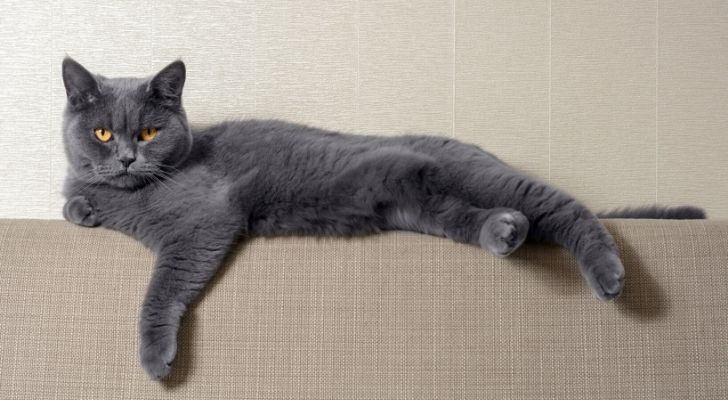
When you come to think about it, it’s an incredibly cat-like thing to do.
Researchers in Japan conducted experiments by playing recordings of cat owners and strangers in the presence of the cats and took note of their reactions.
The cats clearly recognized their owner’s voices while paying no attention to the strangers.
However, in both cases, they didn’t bother getting up to investigate the sounds.
The most widely syndicated cartoon in the world is Garfield, the lasagna-loving cat.

In terms of publication, to syndicate means to publish in a number of newspapers, magazines, and so on at the same time.
In terms of Garfield being the most widely syndicated cartoon, it means that it holds the record for the number of different places it’s published every time a new comic strip is published!
The first Garfield comic was released to just 41 newspapers in 1978.
By the time it gained world-record status in 2002, the comic was being published in 2,570 newspapers worldwide!
The best “mouser” in the world was a cat called Towser.

The long-haired tortoiseshell feline was born on April 21, 1963, and was owned by the Glenturret Distillery Ltd, a whiskey distillery near the town of Crieff, Scotland.
From 1963 until her death in 1987, she prowled the distillery at night, keeping it safe from any intruding rodents.
It is estimated that over the course of her life, she caught some 28,889 mice, averaging 3 mice per night.
If you visit the Glenturret distillery, check out the bronze statue of Towser in the visitor’s center.
A train station in Japan employs cats as stationmasters.

The first in a line of stationmaster cats was Tama, a black, white, and orange calico cat who had taken up residence by Kishi Station in the Wakayama Prefecture.
She was awarded the position in 2007, shortly after budget cuts lead to a drop in staff along the train line.
Instead of a salary, she was given a year’s supply of cat food and a custom-made stationmaster’s hat.
And she was given a gold tag, which displayed her name and official position!
Tama went on to become the honorary president of the railway line for life in 2013.
Cute videos of cats have been around for more than 100 years.
The first known film of cats was created in 1894 by Thomas Edison, the famous inventor of the electric light bulb.
The short film was titled “Boxing Cats” and was, unsurprisingly, a video of two cats boxing!
He was rather fascinated by the idea of the film and went on to create a bizarre series of short films.
The films included an employee of his sneezing and a trapeze artist disrobing, among other things.
If you’ve just read the last 100 cat facts and got to this point, I congratulate you!
You must be as big of a lover of cats as I am, and that’s no easy task! Why else would I spend days writing cat facts?!
It’s difficult not to love cats; they’ve been with us for thousands of years, keeping us company.
And it’s easy to assume that they’ll keep lording over our houses for many, many more years!
If you loved reading these cat facts, please share them with your friends!
Also, check out our other facts about cats below if you’ve not had enough yet!

